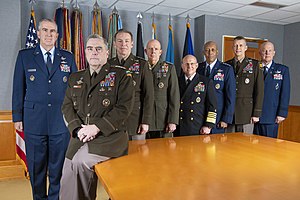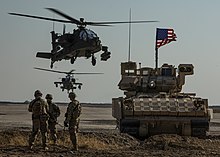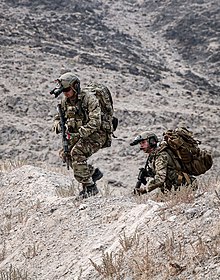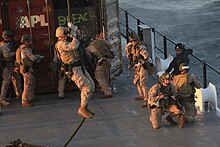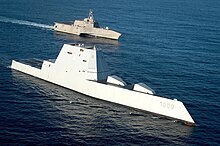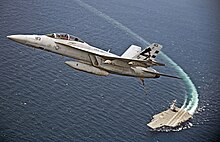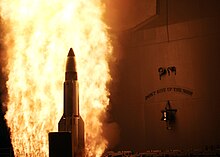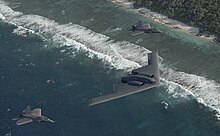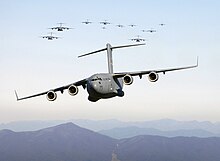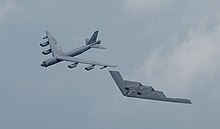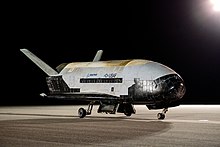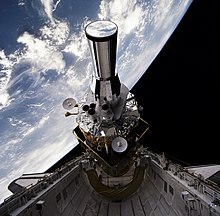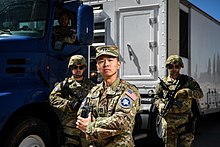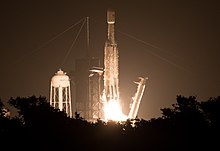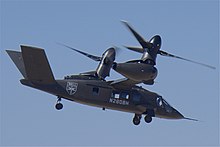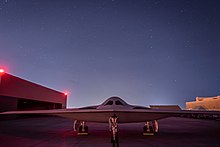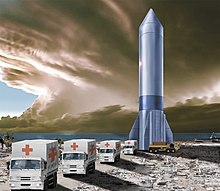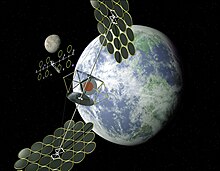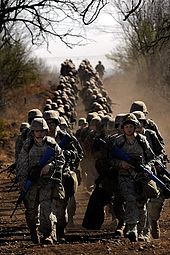Главные люди в ВС США это 4х звездные генералы, их, по закону, есть всего 40 человек. Примерно 1/3 работают в Пентагоне, другие 2/3 живут и работают на военных базах по всему миру и отвечают за военные силы США в различных регионах.
Каждого 4х звездного Генерала назначает Президент США и они должны быть одобрены Сенатом. Кстати, каждый офицер ВС США должен быть одобрен Сенатом и все их повышения тоже.
Генералы должны быть минимум Магистром (Кандидатом Наук) в своем деле. Генералы должны уходить в отставку после 40 лет службы или на 64-ый день рождения. Как и все военнослужащие, Генералы два раза в год обязаны проходить тест на физическую форму (отжимания, sit ups, бег 2 мили на время) и должны быть в пропорции рост и вес.
Штабные генералы имеют свой аппарат в 20-40 сотрудников, которые помогают их прямой деятельности и еще под ними 1 000 – 10 000 аналитиков и офисных сотрудников, работающих на их благо. Сегодня Я работаю на такой аппарат. Все эти люди из ВС, но на их работе стрелять не нужно, хотя обучения они все проходят.
Жизнь Генерала не легка и зарабатывают они не много, $20 000 в месяц, а на гражданке могли получить в 5-10 рах больше, как консультант, лоббист или руководитель. Но у них есть много бенефитов от государства, в их расположении много помощников, особняк, частный самолет, машина с водителем, если нужно охрана и для официальных приемов повар.
Но использовать все это они могут только в рабочих целях. Генерал не имеет доступ к машине с водителем на выходных и он не может поехать на служебной машине в магазин или послать помощника. Время от времени есть скандалы, когда Генерал использовал своих подчиненых для помощи с частной вечеринкой, или по личным делам, и за это их наказывают и увольняют.
Теперь самое главное про Генералов США. Они подчиняются Главным Секретарям Армии, Флота, Воздушных сил, а это все ГРАЖДАНСКИЕ люди, которых тоже назначает Президент США и они тоже должны быть одобрены Сенатом. И именно эти гражданские люди, обычно бывшие дипломаты или чиновники, чаще Генералов общаются с Конгрессом, Сенатом и Президентом США и советуют их действия.
Так было задумано Отцами Основателями США в 1776 году, назначить гражданских чиновников над Генералами, чтобы ВС не стали слишком сильные и самостоятельные. И по моему мнению, это очень правильно.
http://jewbergslist.com/2016/10/10/как-устроено-руководство-военных-сил/
«US Forces» redirects here. For the Midnight Oil song, see US Forces (song).
| United States Armed Forces | |
|---|---|
     
Emblems of the U.S. Armed Forces’ service branches |
|
| Founded | 14 June 1775; 247 years ago[a] |
| Service branches |
|
| Headquarters | The Pentagon, Arlington County, Virginia |
| Leadership | |
| Commander-in-Chief | |
| Secretary of Defense | |
| Secretary of Homeland Security | |
| Chairman of the Joint Chiefs of Staff | |
| Vice Chairman of the Joint Chiefs of Staff | |
| Senior Enlisted Advisor to the Chairman | |
| Personnel | |
| Military age | 17 with parental consent, 18 for voluntary service.[b] |
| Conscription | Only males register at age 18 (conscription inactive since 1973) |
| Available for military service |
15 million (2021)[5], age 18–25 |
| Active personnel | 1,328,000[6] (ranked 3rd) |
| Reserve personnel | 799,500[7] |
| Expenditures | |
| Budget | |
| Percent of GDP | 3.47% (2022)[9] |
| Industry | |
| Domestic suppliers | List |
| Foreign suppliers | |
| Annual imports | US$8.904 billion (2010–2021)[10] |
| Annual exports | US$115.5 billion (2010–2021)[10] |
| Related articles | |
| History | Military history of the United States
List of engagements American Revolutionary War
Las Cuevas War
Persian Gulf War
Bosnian War
Kosovo War
1999 East Timorese crisis
Military deployment after Hurricane Katrina |
| Ranks | Commissioned officer
Warrant officer
Enlisted
|
The United States Armed Forces are the military forces of the United States.[11] The armed forces consists of six service branches: the Army, Marine Corps, Navy, Air Force, Space Force, and Coast Guard.[12][13] All six armed services are among the eight uniformed services of the United States.[14]
Each of the different military services is assigned a role and domain. The U.S. Army conducts land operations, while the U.S. Navy and U.S. Marine Corps conduct maritime operations, with the Marine Corps specializing in amphibious and maritime littoral operations in support of the Navy. The U.S. Air Force conducts air operations, while the U.S. Space Force conducts space operations. The U.S. Coast Guard is unique in that it is a military branch specializing in maritime operations and also a law enforcement agency.[15][16]
From their inception during the American Revolutionary War, the U.S. Armed Forces have played a decisive role in the history of the United States. They helped forge a sense of national unity and identity through victories in the First Barbary War and the Second Barbary War. They played a critical role in the territorial evolution of the United States, including the American Civil War. The National Security Act of 1947, adopted following World War II, created the modern U.S. military framework. The Act established the National Military Establishment, headed by the secretary of defense; and created the United States Air Force and the National Security Council. It was amended in 1949, renaming the National Military Establishment the Department of Defense, and merged the cabinet-level Department of the Army, Department of the Navy, and Department of the Air Force, into the Department of Defense.
The president of the United States is the commander-in-chief of the armed forces and forms military policy with the Department of Defense (DoD) and Department of Homeland Security (DHS), both federal executive departments, acting as the principal organs by which military policy is carried out.
The U.S. Armed Forces are one of the largest military forces in terms of personnel. They draw their personnel from a large pool of professional volunteers. Although military conscription has been used in the past, it has not been used in the U.S. since 1973. The Selective Service System retains the power to conscript males, and requires that all male citizens and residents residing in the U.S. between the ages of 18–25 register with the service.
The U.S. Armed Forces are considered the world’s most powerful military.[17] The military expenditure of the United States was US$877 billion in 2022, the highest in the world, accounting for 39 percent of the world’s defense expenditures.[18] The U.S. Armed Forces has significant capabilities in both defense and power projection due to its large budget, resulting in advanced and powerful technologies which enables a widespread deployment of the force around the world, including around 800 military bases outside the United States.[19] The U.S. Air Force is the world’s largest air force, while the U.S. Army Aviation Branch is the second largest. The U.S. Naval Air Forces is the fourth largest air arm in the world and is the largest naval aviation service, while U.S. Marine Corps Aviation is the world’s seventh largest air arm. The U.S. Navy is the world’s largest navy by tonnage.[20] The U.S. Coast Guard is the world’s 12th largest maritime force.[21] The U.S. Space Force is the world’s only active independent space force.[22]
History
The history of the U.S. Armed Forces dates back to 14 June 1775, with the creation of the Continental Army, even before the Declaration of Independence marked the establishment of the United States.[23] The Continental Navy, established on 13 October 1775, and Continental Marines, established on 10 November 1775, were created in close succession by the Second Continental Congress in order to defend the new nation against the British Empire in the American Revolutionary War.[24][25]
These forces demobilized in 1784 after the Treaty of Paris ended the Revolutionary War. The Congress of the Confederation created the current United States Army on 3 June 1784.[23] The United States Congress created the current United States Navy on 27 March 1794 and the current United States Marine Corps on 11 July 1798.[24][26] All three services trace their origins to their respective Continental predecessors. The 1787 adoption of the Constitution gave Congress the power to «raise and support armies», to «provide and maintain a navy» and to «make rules for the government and regulation of the land and naval forces», as well as the power to declare war. The President of the United States is the U.S. Armed Forces’ commander-in-chief.[27]
The United States Coast Guard traces its origin to the formation of the Revenue Cutter Service on 4 August 1790, which merged with the United States Life-Saving Service on 28 January 1915 to establish the Coast Guard.[28][29] The United States Air Force was established as an independent service on 18 September 1947; it traces its origin to the formation of the Aeronautical Division, U.S. Signal Corps, which was formed 1 August 1907 and was part of the Army Air Forces before being recognized as an independent service in the National Security Act of 1947.[30] The United States Public Health Service Commissioned Corps was formerly considered to be a branch of the United States Armed Forces from 29 July 1945 until 3 July 1952, and is now one of the eight uniformed services of the United States[31]
The United States Space Force was established as an independent service on 20 December 2019. It is the sixth branch of the U.S. military and the first new branch in 72 years.[32] The origin of the Space Force can be traced back to the Air Force Space Command, which was formed 1 September 1982 and was a major command of the United States Air Force.[33]
Structure
Presidential command over the U.S. Armed Forces is established in Article II in the Constitution whereby the president is named as the «Commander in Chief of the Army and Navy of the United States, and of the Militia of the several States, when called into the actual Service of the United States.»[34] The United States Armed Forces are split between two cabinet departments, with the Department of Defense serving as the primary cabinet department for military affairs and the Department of Homeland Security responsible for administering the United States Coast Guard.[35]
The military chain of command flows from the President of the United States to the secretary of defense (for services under the Defense Department) or secretary of homeland security (for services under the Department of Homeland Security), ensuring civilian control of the military. Within the Department of Defense, the military departments (Department of the Army, United States Department of the Navy, and Department of the Air Force) are civilian led entities that oversee the coequal military service branches organized within each department. The military departments and services are responsible for organizing, training, and equipping forces, with the actual chain of command flowing through the unified combatant commands.[36]
The Joint Chiefs of Staff in December 2020
The Joint Chiefs of Staff, although outside the operational chain of command, is the senior-most military body in the United States Armed Forces. It is led by the Chairman of the Joint Chiefs of Staff, who is the military head of the armed forces and principal advisor to the president and secretary of defense on military matters. Their deputy is the Vice Chairman of the Joint Chiefs of Staff. Other members include the chief of staff of the Army, commandant of the Marine Corps, chief of naval operations, chief of staff of the Air Force, chief of space operations, and the chief of the National Guard Bureau.[37] The commandant of the Coast Guard is not an official member of the Joint Chiefs, but sometimes attends meetings as the one of the military service chiefs. The Senior Enlisted Advisor to the Chairman is the most senior enlisted member in the United States Armed Forces.[38]
Leadership of the Armed Forces, to include the president of the United States, Secretary of Defense, Secretary of Homeland Security and Chairman of the Joint Chiefs of Staff are members of the United States National Security Council, which advises the president on national security, military, and foreign policy matters.[39] The National Security Advisor, Homeland Security Advisor, and the Deputy National Security Advisor may also be members of the United States Armed Forces.[40][41] The National Security Council Deputies Committee also includes the Deputy Secretary of Defense, Deputy Secretary of Homeland Security, and Vice Chairman of the Joint Chiefs of Staff.[42] Military leadership, including the Secretary of Defense, United States Secretary of Homeland Security, and Chairman of the Joint Chiefs of Staff also sit on the National Space Council.[43]
Unified combatant commands
Unified combatant commands areas of responsibility
Unified combatant commands are joint military commands consisting of forces from multiple military departments, with their chain of command flowing from the president, to the secretary of defense, to the commanders of the combatant commands. Each service organizes, trains, and equips forces that are then presented to the unified combatant commands through service component commands. Special Operations Command and Cyber Command also present theater special operations commands or joint force headquarters – cyber to other combatant commanders. Army components are typically dual-hatted as the joint force land component, Navy components are typically dual-hatted as the joint force maritime component, and Air Force components are typically dual-hatted as the joint force air component, with the theater special operations command dual-hatted as the joint force special operations component, and Space Force component typically dual-hatted as the joint force space component.[44]
| Name | Mission | Headquarters | Subunified commands | Service components | |
|---|---|---|---|---|---|

|
U.S. Africa Command (USAFRICOM) | Conducts U.S. military operations in Africa. | Kelley Barracks, Germany |
|
|

|
U.S. Central Command (USCENTCOM) | Conducts U.S. military operations in the Middle East and Central Asia. | MacDill Air Force Base, Florida |
|
|

|
U.S. Cyber Command (USCYBERCOM) | Conduct U.S. military cyber operations. | Fort Meade, Maryland |
|
|

|
U.S. European Command (USEUCOM) | Conducts U.S. military operations in Europe. | Patch Barracks, Germany |
|
|

|
U.S. Indo-Pacific Command (USINDOPACOM) | Conducts U.S. military operations in the Indo-Pacific. | Camp H. M. Smith, Hawaii |
|
|

|
U.S. Northern Command (USNORTHCOM) | Conducts U.S. military operations in North America and homeland defense operations. | Peterson Space Force Base, Colorado |
|
|

|
U.S. Southern Command (USSOUTHCOM) | Conducts U.S. military operations in Central America, South America, and the Caribbean. | Doral, Florida |
|
|

|
U.S. Space Command (USSPACECOM) | Conducts U.S. military operations in outer space. | Peterson Space Force Base, Colorado |
|
|

|
U.S. Special Operations Command (USSOCOM) | Develops and employs special operations forces. | MacDill Air Force Base, Florida |
|
|

|
U.S. Strategic Command | Conduct strategic deterrence, nuclear operations, nuclear command, control, and communications, joint electromagnetic spectrum operations, global strike, and missile defense operations.[45] | Offutt Air Force Base, Nebraska |
|
|

|
U.S. Transportation Command | Conduct globally integrated mobility operations. | Scott Air Force Base, Illinois |
|
Combat support agencies
Combat support agencies are Department of Defense agencies that have a combat support mission, involving providing support for operating forces engaged in planning for, or conducting, military operations, including support during conflict or in the conduct of other military activities related to countering threats to U.S. national security. This mission is focused on providing support to echelons at the CCMD level and below and may not encompass the full scope of the CSA’s mission.[46]
| Name | Mission | Headquarters | |
|---|---|---|---|

|
Defense Contract Management Agency (DCMA) | Provide contract administration services for the Department of Defense.[47] | Fort Lee, Virginia |

|
Defense Health Agency (DHA) | Provide and augment medical capabilities for combatant commands.[48] | Falls Church, Virginia |

|
Defense Information Systems Agency (DISA) | Provide, operate and assure command, control, information-sharing capabilities.[49] | Fort Meade, Maryland |

|
Defense Intelligence Agency (DIA) | Provide military intelligence to warfighters, defense policymakers and force planners in the Department of Defense and Intelligence Community, in support of U.S. military planning and operations and weapon systems acquisition.[50] | Defense Intelligence Agency Headquarters, Joint Base Anacostia–Bolling, Washington D.C. |

|
Defense Logistics Agency (DLA) | Manages the end-to-end global defense supply chain.[51] | Fort Belvoir, Virginia |

|
Defense Threat Reduction Agency (DTRA) | Identify, develop, and field solutions to counter weapons of mass destruction and emerging threats.[52] | Fort Belvoir, Virginia |

|
National Geospatial-Intelligence Agency (NGA) | Delivers geospatial intelligence to policymakers, military service members, intelligence professionals and first responders.[53] | Fort Belvoir, Virginia |
 
|
National Security Agency / Central Security Service (NSA/CSS) | Provides timely and accurate cryptologic support, knowledge, and assistance to the military cryptologic community.[54] Provide actionable signals intelligence and cybersecurity support to the Armed Forces.[55] | Fort Meade, Maryland |
Service branches
The United States Armed Forces is composed of six coequal military service branches. Five of the branches, the United States Army, United States Marine Corps, United States Navy, United States Air Force, and United States Space Force are organized under the Department of Defense’s military departments. The United States Coast Guard is nominally under the Department of Homeland Security, but may be transferred to the Department of Defense’s Department of the Navy (which is the civilian entity that oversees the coequal U.S. Marine Corps and U.S. Navy) at the direction of the president or congress. With the exception of the Coast Guard, the military services only organize, train, and equip forces. The unified combatant commands are responsible for operational control of non-service retained forces.
Each of the different military services is assigned a role and domain. The U.S. Army conducts land operations, while the U.S. Navy and U.S. Marine Corps conduct maritime operations, with the Marine Corps specializing in amphibious and maritime littoral operations in support of the Navy. The U.S. Air Force conducts air operations, while the U.S. Space Force conducts space operations. The U.S. Coast Guard is unique in that it is a military branch specializing in maritime operations and also a law enforcement agency.[15][16]
U.S. Army
The United States Army (USA) is the United States Armed Forces’ land force and is the largest and oldest service. Originally established in 1775 as the Continental Army, it consists of one million soldiers across the Regular Army, Army Reserve, and Army National Guard.[56] The Army serves as the Armed Forces principal land service, responsible for conducting land warfare operations.[57]
The U.S. Army is organized under the Department of the Army, which is a military department under the leadership of the secretary of the Army and under secretary of the Army. The U.S. Army itself is led by the chief of staff of the Army and vice chief of staff of the Army, both generals who are advised by the sergeant major of the Army.[58]
The Army’s primary responsibility is to conduct prompt and sustained land combat as part of the joint force. Army landpower focuses on destroying an enemy’s armed forces, occupying its territory, and breaking the will of an adversary.[59]
The five core competencies of the Army are:
- Prompt and sustained land combat
- Combined arms operations:
- Combined arms maneuver and wide area security
- Armored and mechanized operations
- Airborne and air assault operations
- Special operations
- Set and sustain the theater for the joint force
- Integrate national, multinational, and joint power on land[59]
The thirteen specified functions of the Army are:
- Conduct prompt and sustained combined arms combat operations on land in all environments and types of terrain, to include complex urban environments, in order to defeat enemy ground forces, and seize, occupy, and defend land areas.[60]
- Conduct air and missile defense to support joint campaigns and assist in achieving air superiority. This is conducted by the Army’s Air Defense Artillery Branch, specifically by the 10th Army Air and Missile Defense Command, 32nd Army Air and Missile Defense Command, 94th Army Air and Missile Defense Command, 263rd Army Air and Missile Defense Command, and Army Space and Missile Defense Command.[60]
- Conduct airborne and air assault, and amphibious operations. The Army has primary responsibility for the development of airborne doctrine, tactics, techniques, and procedures. Army airborne and air assault operations are conducted by the XVIII Airborne Corps, 11th Airborne Division, 82nd Airborne Division, 101st Airborne Division, and the 173rd Airborne Brigade.[60]
- Conduct civil affairs operations. Civil affairs operations are conducted by the United States Army Special Operations Command, predominantly under United States Army Civil Affairs and Psychological Operations Command and the 95th Civil Affairs Brigade.[60]
- Conduct riverine operaitons.[60]
- Occupy territories abroad and provide for the initial establishment of a military government pending transfer of this responsibility to other authorities.[60]
- Interdict enemy sea power, space power, air power, and communications through operations on and from the land.[60]
- Provide logistics to joint operations and campaigns, including joint over-the-shore and intra-theater transport of time-sensitive, mission-critical personnel and materiel. This is primarily conducted through the Army Logistics Branch, including the Quartermaster Corps, Ordnance Corps, Transportation Corps, and through Army Materiel Command’s Military Surface Deployment and Distribution Command.[60]
- Provide support to space operations to enhance joint campaigns, in coordination with the other military services (primarily the United States Space Force), combatant commands (primarily United States Space Command), and other U.S. government departments and agencies. Army space operations are conducted by Army Space and Missile Defense Command.[60]
- Conduct authorized civil works programs, to include projects for the improvement of navigation, flood control, beach erosion control, and other water resource developments in the United States, its territories, and its possessions, and conduct other civil activities prescribed by law. These are conducted by the Army Corps of Engineers.[60]
- Provide intra-theater aeromedical evacuation. These missions are flown by the Army Medical Service Corps and Army Aviation Branch.[60]
- Conduct reconnaissance, surveillance, and target acquisition.
- Operate land lines of communication. This is primarily conducted through the Transportation Corps and Military Surface Deployment and Distribution Command.[60]
Infantry
The Infantry Branch forms the core of the service’s land combat power. U.S. Army infantry are generally equipped with the M4 carbine and M249 light machine gun, which will be replaced by the XM7 rifle and XM250.[61]
Infantry is a core part of the Army’s Brigade Combat Teams. The most numerous variant, the Infantry Brigade Combat Team, comprise light infantry battalions who fight on foot. Infantry Brigade Combat Teams of the 82nd Airborne Division are air assault capable, with infantry soldiers being transported by U.S. Army Aviation UH-60 Black Hawk and CH-47 Chinook helicopters.[62] Infantry Brigade Combat Teams of the 11th Airborne Division, 82nd Airborne Division, and 173rd Airborne Brigade are capable of airborne operations, in cooperation with the U.S. Air Force’s transport aircraft.[63] Finally, Infantry Brigade Combat Teams assigned to the 10th Mountain Division specialized in mountain warfare.[64] Standard Infantry Brigade Combat Teams are assigned to the 25th Infantry Division, which offers additional training in jungle warfare.[65]
Armored Brigade Combat Teams comprise mechanized infantry battalions mounted in the M2 Bradley infantry fighting vehicle. Divisions with Armored Brigade Combat Teams include the 1st Infantry Division, 3rd Infantry Division, 4th Infantry Division, 1st Armored Division, and 1st Cavalry Division.[66] Stryker Brigade Combat Teams are centered around Stryker infantry battalions operating out of the Stryker. Divisions with Stryker Brigade Combat Teams include the 2nd Infantry Division, 4th Infantry Division, 11th Airborne Division, 2nd Cavalry Regiment, and 3rd Cavalry Regiment.[67]
United States Army Rangers with the 75th Ranger Regiment are an elite special operations infantry force in United States Army Special Operations Command, specializing in air assault and airborne infiltration methods. The three primary missions of the 75th Ranger Regiment are special operations raids, forcible entry operations, such as an airfield seizure to enable the Air Force to bring in more forces, and special reconnaissance.[68][69] As a special operations force, Army Rangers are generally better equipped than standard infantry, utilizing the FN SCAR rifle.[70]
Army Special Forces
Army Special Forces, commonly known as Green Berets after their iconic headgear, are among the most elite soldiers in the Army. Special Forces conduct unconventional warfare, enabling a resistance movement or insurgency to coerce, disrupt, or overthrow a government or occupying power by operating through or with an underground force in a denied area, foreign internal defense, training and equipping foreign allied military forces to defend against insurgency, subversion, terrorism, and other security threats, and security force assistance, training and developing the defense capabilities of friendly and developing nations. More direct missions include counterinsurgency, direct action, and special reconnaissance in hostile, denied, or diplomatically or politically sensitive environments, to collect or verify information of strategic significance.[71] Special Forces are trained military free-fall parachuting and combat diver skillsets.[72] Army Special Forces are considered the most versatile special operations force in the entire world, operating as a multi-purpose force since 1952.[73]
Armor and Cavalry
The Armor Branch traces its history back to the United States Cavalry, and are responsible for tank and cavalry reconnaissance operations.[74]
The U.S. Army fields the M1 Abrams main battle tank in Armored Battalions as part of Armored Brigade Combat Teams across the 1st Armored Division, 1st Cavalry Division, 1st Infantry Division, 3rd Infantry Division, and the 4th Infantry Division. Each Armored Brigade Combat Team also possesses a cavalry squadron equipped with M2 Bradleys for scouting and security. Styker Brigade Combat Teams from the 2nd Infantry Division, 4th Infantry Division, 11th Airborne Division, 2nd Cavlary Regiment, and 3rd Cavalry Regiment have a cavalry squadron equipped with Strykers. Infantry Brigade Combat Teams from the 10th Mountain Division, 11th Airborne Division, 25th Infantry Division, 82nd Airborne Division, 101st Airborne Division, and 173rd Airborne Brigade have a cavalry squadron equipped with the Joint Light Tactical Vehicle.[75]
Field Artillery
The Field Artillery’s mission is to destroy, suppress or neutralize the enemy by cannon, rocket or missile fire.[76] Rocket systems include the M142 HIMARS and M270 Multiple Launch Rocket System, which are corps-level asset found in field artillery brigades. Towed artillery includes the M119 howitzer in Infantry Brigade Combat Teams and the M777 howitzer found in both Infantry and Stryker Brigade Combat Teams. The M109 self-propelled howitzer is utilized in Armored Brigade Combat Teams.[77]
During the Cold War, Army field artillery was responsible for the service’s ballistic missile programs, including the PGM-11 Redstone, which was the first large ballistic missile in the U.S. arsenal, the MGM-31 Pershing, and the Pershing II.[78] In 2023, the Army is intending to field the Long-Range Hypersonic Weapon and has reestablished larger artillery formations like the 56th Artillery Command.[79][80][81]
Air Defense Artillery
The Air Defense Artillery is responsible for defending geopolitical assets and providing maneuver forces with the freedom to move on the battlefield by deterring the enemy and destroying aerial threats, missile attacks, and surveillance platforms.[82] Weapons employed by Air Defense Artillery include the FIM-92 Stinger man-portable air-defense system, AN/TWQ-1 Avenger, for short range air defense, and the counter rocket, artillery, and mortar 20mm gun system. The Iron Dome provides air defense against rockets, artillery, mortars, missiles, and unmanned aerial vehicles, while the MIM-104 Patriot is capable of defeating a wide range of threats including aircraft, helicopters, UAVs, ballistic and cruise missiles, and Weapons of Mass Destruction.[83]
The Terminal High Altitude Area Defense protects strategic critical assets by conducting long-range endo-and-exo-atmospheric engagements of ballistic missiles using the world’s largest air-transportable X-band radar. The Ground-Based Midcourse Defense is an anti-ballistic missile system operated by Army Space and Missile Defense Command to defend the United States homeland against an intercontinental ballistic missile attack.[84] Major Air Defense Artillery units include the 32nd Army Air and Missile Defense Command and Army Space and Missile Defense Command’s 100th Missile Defense Brigade.[85][86]
Air Defense Artillery has an extremely close relationship with the Air Force through its Air and Missile Defense Commands and the Space Force through Army Space and Missile Defense Command, given their shared missile defense and space roles. In 1962, Air Defense Artillery achieved the first intercept of a ballistic missile with a nuclear-tipped Nike Zeus and operated the Nike Zeus as an anti-satellite weapon after completing a successful intercept in 1963.[87][88]
Army Aviation
Army Aviation, distinct from the U.S. Air Force and its predecessors, began as part of the field artillery in 1942. Small spotter planes were used to spot for artillery and naval bombardment, as well as to perform observation. These few aircraft formed the core of Army Aviation once the U.S. Air Force gained independence. In 1983, the Army created the Aviation Branch, for the first time since the Air Force’s independence consolidating aviation under a single organization.[89]
The mission of Army Aviation is to find, fix and destroy any enemy through fire and maneuver and to provide combat support and combat service support in coordinated operations as an integral member of the combined arms team.[90] Major aircraft include the AH-64 Apache, which serves as the Army’s attack helicopter, the UH-60 Black Hawk, and the CH-47 Chinook for troop and cargo transport. Army Aviation also flies the MQ-1C Gray Eagle drone.[91]
A specialized unit within Army Aviation, the 160th Special Operations Aviation Regiment (Airborne) serves as a special operations unit and operates modified variants of the MH-60 Black Hawk, MH-47 Chinook, and the MH-6 Little Bird.[92]
Army Cyber Corps and Army Signal Corps
Established in 2014, the Army Cyber Corps is responsible for conducting cyberspace operations, electronic warfare, and information operations. The Cyber Corps was created by merging resources from the Army Signal Corps and the Military Intelligence Corps.[93] The Signal Corps is responsible for running the U.S. Army’s communications networks.[94]
The Army Signal Corps was previously responsible for operating the Army’s payloads on the Wideband Global SATCOM satellite through the 53rd Signal Battalion. In 2022, the Army transferred its mission to the Space Force’s 53rd Space Operations Squadron, ending the Signal Corps’ space mission.[95]
Army commands
The U.S. Army is organized into four major Army Commands, nine Army Service Component Commands, which serve as the Army component and joint force land component commanders for the unified combatant commands, and thirteen direct reporting units.[96]
| Name | Mission | Headquarters | |
|---|---|---|---|

|
Headquarters Department of the Army (HQDA) | Army service headquarters led by the chief of staff of the Army. | The Pentagon, Virginia |
| Army Commands and reserve components | |||

|
U.S. Army Forces Command (FORSCOM) | Provides Army land forces to unified combatant commands.[97] | Fort Bragg, North Carolina |

|
U.S. Army Materiel Command (AMC) | Provides technology, acquisition support, and logistics for Army land forces.[98] | Redstone Arsenal, Alabama |

|
U.S. Army Training and Doctrine Command (TRADOC) | Recruits, trains, and educates Army soldiers and develops Army doctrine.[99] | Fort Eustis, Virginia |

|
U.S. Army Futures Command (AFC) | Leads Army modernization efforts, including developing future force requirements, designing future force organizations, and delivering materiel capabilities.[100] | Austin, Texas |

|
U.S. Army Reserve (USAR) | Oversees and maintains Army reserve forces | Fort Bragg, North Carolina |

|
Army National Guard (ARNG) | Army component of the National Guard. | The Pentagon, Virginia |
U.S. Marine Corps
The United States Marine Corps (USMC) serves as the U.S. Armed Forces’ naval land force, responsible for executing amphibious warfare and operating in the maritime littorals in support of the U.S. Navy. Originally established in 1775 as the Continental Marines, the Marine Corps consists of the Regular Marine Corps and the Marine Corps Reserve.[101] The Marine Corps maintains a very close relationship with the U.S. Navy, its sister service in the Department of the Navy. Although the Marine Corps has previously operated as an independent land force alongside the Army, its primary purpose is to serve as part of a unified naval service alongside the Navy in the maritime domain.[102]
The U.S. Marine Corps is organized under the Department of the Navy, which is a military department under the leadership of the secretary of the Navy and the under secretary of the Navy. The U.S. Marine Corps itself is led by the commandant of the Marine Corps and the assistant commandant of the Marine Corps, both generals who are advised by the sergeant major of the Marine Corps.[101]
The Marine Corps statutory mission is outlined in 10 U.S.C. § 5063 and as originally introduced under the National Security Act of 1947, with its three primary areas of responsibility including:
- Seizure or defense of advanced naval bases and other land operations to support naval campaigns;
- Development of tactics, technique, and equipment used by amphibious landing forces in coordination with the Army and Air Force; and
- Such other duties as the President or Department of Defense may direct.
The seven specified functions of the Marine Corps are:
- Seize and defend advanced naval bases or lodgments to facility subsequent joint operations.[60]
- Provide close air support for ground forces.[60]
- Conduct land and air operations essential to the prosecution of a naval campaign or as directed.[60]
- Conduct complex expeditionary operations in the urban littorals and other challenging environments.[60]
- Conduct amphibious operations, including engagement, crisis response, and power projection operations to assure access. The Marine Corps has primary responsibility for the development of amphibious doctrine, tactics, techniques, and equipment.[60]
- Conduct security and stability operations and assist with the initial establishment of a military government pending transfer of responsibility to other authorities.[60]
- Provide security detachments and units for service on armed vessels of the Navy, provide protection of naval property at naval stations and bases, provide security at designated U.S. embassies and consulates, and perform other such duties as the president or secretary of defense may direct. These additional duties may not detract from or interfere with the operations for which the Marine Corps is primally organized. Marine Corps Security Force Regiment is responsible for supporting the Navy with Marine security operations, while the Marine Security Guard protects embassies and consulates of the United States Department of State.[60]
Fleet Marine Force
The combat power of the Marine Corps is centralized in the Fleet Marine Force (FMF), which itself is organized into Fleet Marine Force Atlantic, to support the U.S. Navy’s Fleet Forces Command, and Fleet Marine Force Pacific, which supports the U.S. Navy’s U.S. Pacific Fleet.[102]
The basic Marine Corps unit for conducting operations is the Marine Air-Ground Task Force (MAGTF), which combines Marine Corps and Navy land, air, sea, and cyberspace capabilities into a single command. There are three different sized variants of a Marine Air-Ground Task Force, but each consists of a command element, ground combat element, aviation combat element, and logistics combat element.[103]
A Marine ground combat element (GCE) is centered around Marine infantry, typically armed with a M27 Infantry Automatic Rifle.[104] Unlike the Army, the Marine Corps does not train their own combat medics, relying on the Navy to provide hospital corpsman.[105] These infantry units are supported by Marine Corps combat engineers, who conduct engineer reconnaissance, obstacle system emplacement, and breaching operations, and Marine Corps Force Reconnaissance teams. While the Marine Corps no longer operates its own tanks, opting to request support from the Army if needed, it maintains Light Armored Reconnaissance Battalions which operates the LAV-25 amphibious armored reconnaissance vehicle. Assault Amphibian Battalions operate the Assault Amphibious Vehicle and Amphibious Combat Vehicle, which enable the ground combat element to conduct amphibious landing operations.[106] Marine Corps artillery operates the M777 howitzer and the M142 HIMARS, both supporting the ground combat element and the Navy at sea by striking enemy ships.[107][108]
The Marine aviation combat element (ACE) is the operational arm of Marine Corps Aviation, working to support the ground combat element. The F-35B Lightning II and AV-8B Harrier II are flown by off of Navy amphibious assault ships, while the F-35C Lightning II and F/A-18 Hornet are flown off of Navy carriers by Marine Corps pilots. The Marine Corps also operates the KC-130J to serve as a tanker and tactical airlift platform. The UH-1Y Venom helicopter provides the Marine Corps with light transport and attack, while the AH-1Z Viper is a dedicated attack helicopter. Medium lift squadrons fly the MV-22 Osprey, while heavy lift squadrons use the CH-53K King Stallion. The Marine Corps has also begun flying unmanned aerial vehciles, such as the MQ-9 Reaper and MQ-8 Fire Scout.[109] Notably, the aviation combat element also includes Low-Altitude Air Defense Battalions, which employ the FIM-92 Stinger surface to air missile.[110]
The smallest MAGTF is the Marine Expeditionary Unit (MEU), which are typically forward deployed on Navy ships. Commanded by a colonel, a Marine Expeditionary Unit consist of 2,200 marines split across a battalion landing team (ground combat element), composite helicopter squadron (aviation combat element), and a combat logistics element (logistics element). Marine Expeditionary Units are supplied for 15 days.[103] Forward deployed Marine Expeditionary Units are often embarked on Navy amphibious assault ships as part of an amphibious ready group.[111]
The next sized MAGTF is the Marine Expeditionary Brigade (MEB), which are organized for specific missions. Commanded by a brigadier general, Marine Expeditionary Brigades consist of 4,000 to 16,000 marines across a Regimental-sized ground combat element, a Marine Aircraft Group, and a Combat Logistics Regiment. Marine Expeditionary Brigades are supplied for 30 days and offer increased firepower and airpower over the Marine Expeditionary Unit.[103]
The largest MAGTF is the Marine Expeditionary Force (MEF), which are primary warfighting forces for larger operations. A Marine Expeditionary Force is commanded by a lieutenant general and consist of 46,000 to 90,000 marines. Currently there are only three Marine Expeditionary Forces, each with its own Marine Division, Marine Aircraft Wing, Marine Logistics Group, and Marine Expeditionary Force Information Group. Marine Expeditionary Forces are supplied for 60 days.[103]Certain elements are held at the Marine Expeditionary Force level, such as Force Reconnaissance. The MEF Information Group (MIG) also provides a number of functions, such as the intelligence battalion, radio battalion which conduct signals intelligence, electronic warfare, and cyberspace operations, communications battalion, the MEF support battalion, and the Air Naval Gunfire Liaison Company.[112][113]
While not a MAGTF, the Marine Corps has begun to reorganize some of its regiments into Marine Littoral Regiments (MRL), which are similar in size to a Marine Expeditionary Unit. A Marine Littoral Regiment is a self-deployable force, designed to be naval in nature and operate in the littoral region. A Marine Littoral Regiment consists of a littoral combat team, a littoral anti-air battalion, and a combat logistics battalion. Notably, the Marine Littoral Regiment has no aviation combat element, unlike a Marine Expeditionary Unit.[114]
Another Marine Corps element that does not function as part of the MAGTF are the Marine Raider Regiment, who function under United States Marine Forces Special Operations Command. Marine Raiders specialize in specialize in direct action, unconventional warfare, maritime interdiction, special reconnaissance, foreign internal defense, counterterrorism, and counterinsurgency missions.[115]
Marine Corps commands
Under Headquarters Marine Corps, the Marine Corps is organized into the Fleet Marine Force, multiple commands, and Marine Corps service components to the unified combatant commands.
| Name | Mission | Headquarters | |
|---|---|---|---|

|
Headquarters Marine Corps (HQMC) | Marine Corps service headquarters led by the commandant of the Marine Corps. | The Pentagon, Virginia |
| Fleet Marine Force | |||

|
Fleet Marine Force, Atlantic (FMFLANT) / U.S. Marine Corps Forces Command (MARFORCOM) | Provides Marine Corps forces in support of the U.S. Navy’s United States Fleet Forces Command. Also serves as United States Marine Corps Forces Command, commanding Marine Corps retained service forces and providing forces for joint, naval, and service requirements.[116] | Naval Support Activity Hampton Roads, Virginia |

|
Fleet Marine Force, Pacific (FMFPAC) | Provides Marine Corps forces in support of the U.S. Navy’s United States Pacific Fleet.[117] | Camp H. M. Smith, Hawaii |

|
Marine Corps Systems Command (MARCORSYSCOM) | Acquisition command for all Marine Corps ground and information technology programs.[118] | Marine Corps Base Quantico, Virginia |

|
U.S. Marine Corps Forces Reserve (MARFORRES) | Oversees and maintains the U.S. Marine Corps reserve forces.[119] | Marine Corps Support Facility New Orleans, Louisiana |
U.S. Navy
The United States Navy (USN) is the United States Armed Forces’ maritime force. Originally established in 1775 as the Continental Navy, the U.S. Navy consists of the Regular Navy and the Navy Reserve. The Navy is the United States’ principal maritime service, responsible for maritime warfare operations.[120]
The U.S. Navy is organized under the Department of the Navy, which is a military department under the leadership of the secretary of the Navy and the under secretary of the Navy. The U.S. Navy itself is led by the chief of naval operations and the vice chief of naval operations, both admirals who are advised by the master chief petty officer of the Navy.[120]
The five enduring functions of the Navy are:[121]
- Sea control
- Power projection
- Deterrence
- Maritime security
- Sealift
The nine specified tasks of the Navy are:
- Conduct offensive and defensive operations associated with the maritime domain including achieving and maintaining sea control, to include subsurface, surface, land, air, space, and cyberspace.[60]
- Provide power projection through sea-based global strike, to include nuclear and conventional capabilities; interdiction and interception capabilities, maritime and/or littoral fires, to include naval surface fires; and close air support for ground forces.[60]
- Conduct ballistic missile defense. This is executed through the Navy’s Aegis Ballistic Missile Defense System.[60]
- Conduct ocean, hydro, and river survey and reconstruction.[60]
- Conduct riverine operations. This is conducted by the Maritime Expeditionary Security Force and Naval Special Warfare Command.[60]
- Establish, maintain, and defense sea bases in support of naval, amphibious, land, air, or other joint operations as directed.[60]
- Provide naval expeditionary logistics to enhance the deployment, sustainment, and redeployment of naval forces and other forces operating within the maritime domain, to include joint sea bases, and provide sea transport for the Armed Forces other than which is organic to the individual military services, United States Special Operations Command, and United States Cyber Command. This is conducted by the Navy Expeditionary Logistics Support Group and Military Sealift Command.[60]
- Provide support for joint space operations to enhance naval operations, in coordination with the other military services (primarily the United States Space Force), combatant commands (primarily United States Space Command), and other U.S. government departments and agencies. U.S. Navy space operations are conducted by Navy Space Command.[60]
- Conduct nuclear operations in support of strategic deterrence, to include providing and maintaining nuclear surety and capabilities.[60]
Naval Surface Forces
The Naval Surface Forces (NAVSURFOR) is the backbone of the U.S. Navy’s combat power, conducting surface warfare operations and operating its fleet of combat surface ships.[122]
The Naval Surface Forces operates eleven nuclear powered aircraft carriers (CVN), split between the Nimitz-class and the newer Gerald R. Ford-class. Aircraft carriers are the centerpiece of the U.S. Navy’s combat power, forming the nucleus of its eleven carrier strike groups (CSG). Each aircraft carrier has an embarked carrier air wing from the Naval Air Forces.[123]
The Naval Surface Forces also operate 116 surface combatants. These include the Ticonderoga-class guided-missile cruisers, Arleigh Burke-class guided-missile destroyers (DDG) and Zumwalt-class stealth guided-missile destroyers. Cruisers and destroyers ofthen operate as part of a larger formations, where they serve as escorts for anti-aircraft and anti-submarine operations, but they also are able to conduct sea control and striker operations ashore with their tomahawk cruise missiles. The Navy also operates a complement smaller of Freedom-class and Independence-class littoral combat ships (LCS) that can be modularly reconfigured for specific mission sets.[124][125] Having lacked a frigate since the Oliver Hazard Perry-class was decommissioned, the Navy is in the process of acquiring the new Constellation-class guided-missile frigates (FFG).[126]
Finally, the Naval Surface Forces operate 31 amphibious warfare ships to support the Fleet Marine Force and its embarked Marine Air-Ground Task Forces as part of an amphibious ready group or expeditionary strike group. This includes the America-class landing helicopter assault (LHA) ships which can carry U.S. Marine Corps F-35B Lightning II fighters and helicopters, and Wasp-class landing helicopter dock (LHD) ships, which can carry both F-35B fighters, helicopters, and landing craft. These are in addition to the San Antonio-classs amphibious transport docks (LPD), and the Whidbey Island-class and Harpers Ferry-class dock landing ships.[127][128]
Naval Submarine Forces
The Naval Submarine Forces (NAVSUBFOR) is often referred to as the «silent service,» consisting of 68 commissioned submarines.[129]
Los Angeles-class, Seawolf-class, and Virginia-class nuclear-powered attack submarines are capable of performing sea control mission by destroying enemy submarines and surface ships, conducting surveillance and reconnaissance, performing irregular warfare, covert troop insertion, mine and anti-mine operations, and land attack missions with tomahawk cruise missiles.[130]
Ohio-class nuclear-powered ballistic missile submarines (SSBN) have the sole mission of being launch platforms for nuclear submarine-launched ballistic missile (SLBM). Each carries 20 UGM-133 Trident II SLBMs. The Navy is currently in the process of procuring the Columbia-class SSBNs to replace the Ohio-class.[131] Some Ohio-class submarines have been converted to cruise-missile submarines (SSGN), capable of carrying 154 tomahawk cruise missiles and deploying 66 special operations forces personnel, such as Navy SEALs.[132]
Naval Air Forces
The Naval Air Forces (NAVAIRFOR) is the Navy’s naval aviation arm, centered around the carrier air wing. The core of the carrier air wing are the Naval Air Forces strike fighter squadrons (VFA), which fly the F-35C Lightning II stealth fighter and the F/A-18E/F Super Hornet. A variant of the F/A-18, the EA-18G Growler is an electronic-warfare aircraft flown by electronic attack squadrons (VAQ) off of carriers or land bases. The E-2 Hawkeye provides carriers with airborne early warning and command and control, while the C-2A Greyhound keeps carriers supplied. The CMV-22B Osprey is currently in the process of replacing the C-2 Greyhound for carrier resupply.[133]
The Naval Air Forces also operate the MH-60 Seahawk for anti-submarine warfare, anti-ship warfare, and search and rescue operations. The MH-53E is primarily used for anti-mine warfare, but can also be used for assault support.[133]
Although primally centered on carriers, the Naval Air Forces do operate a small number of land-based aircraft. These include the P-3C Orion and P-8A Poseidon, which conduct anti-submarine warfare operations and serve as maritime patrol aircraft, alongside the unmanned MQ-4C Triton. The E-6 Mercury is also flown by the Navy to communicate instructions to U.S. strategic forces.[134][133]
Naval Information Forces
The Naval Information Warfare Forces (NAVINFOR) were created in 2009 to integrate the Navy’s communications, networks, naval intelligence, oceanography, meteorology, cryptology, electronic warfare, cyberspace operations, and space elements into a single organization. The mission of Navy information warfare is to provide assured command and control, battlespace awareness, and integrated fires to achieve freedom of maneuver across all warfighting domains.[135]
In 2022, the Navy lost its only space operations unit when the Naval Satellite Operation Center, established in 1962, and its 13 Navy communications satellites transferred to the U.S. Space Force and became the 10th Space Operations Squadron.[136]
Naval Special Warfare and Naval Expeditionary Combat Forces
Naval Expeditionary Combat Forces, sometimes known as «sand sailors» operate ashore or in the littoral regions under Navy Expeditionary Combat Command.[137] Their purpose is to clear the battlespace of hazards to the navy, secure maritime terrain, sea liens of communication, and resources, build infrastructure, awareness, logistics chains, and partnerships, and protect the Navy’s fleets, facilities, and forces.[138]
Navy Explosive Ordnance Disposal teams are responsible for conducting countering explosive devices that may present a hazard and also are able to clear harbors of navigational hazards, engage in underwater search and rescue, and perform limited underwater repairs on ships.[139] The Maritime Expeditionary Security Force conducts operations in the littoral regions, including harbors, rivers, bays, and on land to provide maritime security operations. These include port and harbor security.[140] The Naval Construction Force, or Seabees, are Navy engineers, able to construct facilities in support of naval operations while also providing force protection.[141]
Naval Special Warfare are maritime special operations forces under Naval Special Warfare Command. These include the United States Navy SEALs and Special warfare combatant-craft crewmen.[142]
Navy commands
The U.S. Navy is organized into eight navy component commands, which command operational forces and serve as joint force maritime component commands, fifteen shore commands, which support the fleets’ operating forces, five systems commands, which oversee the technical requirements of the Navy, and nine type commands, which administratively manage units of a certain type.
| Name | Mission | Headquarters | |
|---|---|---|---|

|
Office of the Chief of Naval Operations (OPNAV) | Navy service headquarters led by the chief of naval operations. | The Pentagon, Virginia |
| Navy operating forces | |||

|
U.S. Fleet Forces Command (USFF) / U.S. Naval Forces Northern Command (NAVFORNORTH) | Trains, certifies, and provides Navy forces for naval, joint, and combined operations. Navy service component and joint force maritime component command to United States Northern Command and United States Strategic Command.[143] | Naval Support Activity Hampton Roads, Virginia |

|
U.S. Pacific Fleet (PACFLT) | Navy service component and joint force maritime component command to United States Indo-Pacific Command. | Naval Station Pearl Harbor, Hawaii |

|
U.S. Naval Forces Central Command (NAVCENT) | Navy service component and joint force maritime component command to United States Central Command. | Naval Support Activity Bahrain |
 
|
U.S. Fleet Cyber Command (FCC) / U.S. Navy Space Command (NAVSPACE) | Navy service component to United States Cyber Command and United States Space Command | Fort Meade, Maryland |

|
U.S. Naval Forces Europe and Africa (NAVEUR-NAVAF) | Navy service component and joint force maritime component command to United States European Command and United States Africa Command. | Naval Support Activity Naples, Italy |

|
U.S. Naval Forces Southern Command (NAVSO) | Navy service component and joint force maritime component command to United States Southern Command. | Naval Station Mayport, Florida |

|
U.S. Naval Special Warfare Command (USNSWC) | Navy service component to United States Special Operations Command. | Naval Amphibious Base Coronado, California |

|
Military Sealift Command (MSC) | Navy service component and joint force maritime component command to United States Transportation Command. | Naval Station Norfolk, Virginia |

|
U.S. Navy Reserve (USNR) | Oversees and maintains Navy reserve forces | Naval Support Activity Hampton Roads, Virginia |
U.S. Air Force
The United States Air Force (USAF) is the United States Armed Forces’ air force. Originally established in 1947 when it gained independence from the U.S. Army, it traces its history back to through the United States Army Air Forces, United States Army Air Corps, United States Army Air Service, the Division of Military Aeronautics, Aviation Section, U.S. Signal Corps, to the birth of Aeronautical Division, U.S. Signal Corps on 1 August 1907. The U.S. Air Force serves as the principal air service, responsible for aerial warfare operations. The U.S. Air Force is composed of the Regular Air Force, Air Force Reserve, and Air National Guard.[144]
The U.S. Air Force is organized under the Department of the Air Force, which is a military department under the leadership of the secretary of the Air Force and under secretary of the Air Force. The U.S. Air Force itself is led by the chief of staff of the Air Force and vice chief of staff of the Air Force, both generals who are advised by the chief master sergeant of the Air Force.
The five core missions of the Air Force are:[145]
- Air superiority
- Global integrated intelligence, surveillance and reconnaissance
- Rapid global mobility
- Global strike
- Command and control
The eight specified functions of the Air Force are:[146]
- Conduct nuclear operations in support of strategic deterrence, to include providing and maintaining nuclear surety and capabilities.
- Conduct offensive and defensive operations, to include appropriate air and missile defense, to gain and maintain air superiority and air supremacy as required, to enable the conduct of operations by U.S. and allied land, sea, air, space, and special operations forces.
- Conduct global precision attack, to include strategic attack, interdiction, close air support, and prompt global strike.
- Provide timely, globally integrated intelligence, surveillance, and reconnaissance capability and capacity from forward deployed locations and globally distributed centers to support world-wide operations.
- Provide rapid global mobility to employ and sustain organic air and space forces and other military service and U. S. Special Operations Command forces, as directed, to include airlift forces for airborne operations, air logistical support, tanker forces for in-flight refueling, and assets for aeromedical evacuation.
- Provide agile combat support to enhance the air and space campaign and the deployment, employment, sustainment, and redeployment of air and space forces and other forces operating within the air and space domains, to include joint air and space bases, and for the Armed Forces other than which is organic to the individual military services and U.S. Special Operations Command in coordination with the other military services, combatant commands, and U.S. Government departments and agencies.
- Conduct global personnel recovery operations including theater-wide combat and civil search and rescue in coordination with the other military services, combatant commands, and DoD components.
- Conduct globally integrated command and control for air and space operations.
Combat Air Force
The Combat Air Force (CAF) comprises the majority of the Air Force’s combat power, consisting of its fighter, bomber, intercontinental ballistic missile, and special operations forces.[147]
The Air Force’s fighter forces are led by Air Combat Command’s Fifteenth Air Force, with other fighter units under Pacific Air Forces and United States Air Forces in Europe. Air Force fighters are predominantly used to achieve air superiority and strike enemy ground and naval forces. The Air Force operates an expanding force of fifth-generation fighters. The F-22A Raptor stealth fighter is designed to replace the F-15C in air superiority operations carrying two AIM-9 Sidewinder and six AIM-120 AMRAAM missiles. It also has a significant air-to-ground mission, carrying two GBU-32 Joint Direct Attack Munition bombs, in addition to two AIM-9 and two AIM-120 missiles.[148] Ultimately, the F-22 is intended to be replaced by the sixth-generation fighter Next Generation Air Dominance program.[149] The F-22 is complemented by the more numerous F-35A Lightning II multi-role stealth fighter, which are in the process of replacing the F-16C fighters and A-10 attack aircraft in air superiority and ground attack roles, to include the nuclear strike mission.[150][151]
The Air Force still operates an extremely sizable force of fourth-generation fighters. The F-15C Eagle is a dedicated air superiority fighter, while the F-15E Strike Eagle was modified to be a duel-role strike fighter, carrying both conventional and nuclear weapons.[152][153] The F-15C Eagle and F-15E Strike Eagle are both being replaced by the F-15EX Eagle II, which is significantly more advanced.[154] The F-16C Fighting Falcon is a multirole fighter that served as the primary Air Force fighter for decades, including as a dual-capable tactical nuclear strike fighter.[155][156] The A-10C Thunderbolt II attack aircraft was the first Air Force fighter specifically designed for the close air support mission, operating against enemy ground forces and light naval ships with its GAU-8 Avenger gatling cannon and array of air to ground munitions.[157]
The Air Force’s bomber forces are organized under Air Force Global Strike Command’s Eighth Air Force, executing long-range strike operations. The B-2A Spirit stealth bomber is capable of conducting both conventional and nuclear strike operations, flying through air defenses.[158] The B-1B Lancer, to contrast, is a supersonic bomber that carries only conventional munitions and serves as the backbone of the bomber force.[159] Both the B-2A Spirit and the B-1B Lancer are being replaced by the B-21 Raider stealth bomber, which can be equipped with both conventional and nuclear munitions.[160] The B-52H Stratofortress is a long-range, heavy bomber that the Air Force has flown since the 1950s and operates a variety of conventional and nuclear munitions, including the AGM-86 air-launched cruise missile.[161]
The Air Force’s intercontinental ballistic missile forces are organized under Air Force Global Strike Command’s Twentieth Air Force, serving as the land-component of the nuclear triad. The LGM-30G Minuteman III serves as the only ballistic missile operated by the Air Force, with 400 stationed in hardened silos.[162] The LGM-30G will be replaced by the LGM-35A Sentinel intercontinental ballistic missile.[163]
The Air Force’s special operations forces are organized under Air Force Special Operations Command, consisting of both special operations aviation and Air Force special tactics airmen on the ground. The AC-130J Ghostrider gunships have the primary mission of close air support and air interdiction, using cannons and precision guided munitions.[164] The MC-130J Commando II, also a variant of the C-130 Hercules, fly exfiltration and resupply operations for special operations forces, along with conducting air to air refueling for helicopters.[165] The CV-22 Osprey is a tiltrotor aircraft used for the infiltration and exfiltration of special operations forces.[166] While not under Air Force Special Operations Command, rescue operations are supported by the HC-130J Combat King II and HH-60W Jolly Green II combat rescue aircraft.[167] The MQ-9 Reaper also serves as remotely piloted intelligence and strike aircraft, serving under Air Force Special Operations Command and Air Combat Command.[168]
Air Force Special Tactics are the ground special warfare force of the U.S. Air Force, integrating air-ground operations. Special Tactics conduct four core missions. Global access teams assess and open airfields, ranging from international airports to dirt strips, in permissive or hostile locations to facilitate the landing and operation of air forces. Precision strike teams are trained to direct aircraft and other forces to conduct kinetic and non-kinetic strikes, as well as humanitarian aid drops. Special Tactics teams also conduct personnel recovery missions, possessing significant medical and rescue experience. Finally, Special Operations Surgical Teams conduct surgery and medical operations in battlefield operations in support of special operations.[169]
The Air Force also operates a wide array of reconnaissance aircraft under Air Combat Command’s Sixteenth Air Force, including the RQ-4 Global Hawk drone, U-2 Dragon Lady, and RC-135 Rivet Joint. Air Force operations are typically supported by command and control aircraft, such as the E-3 Sentry airborne warning and control system. The E-3 Sentry is in the process of being replaced by the E-7A Wedgetail.[170]
Mobility Air Force
The Mobility Air Force (MAF) are organized under Air Mobility Command and comprise the Air Force’s airlift, air refueling, and aeromedical evacuation forces.[171]
The airlift forces operate three different major aircraft. The C-5M Super Galaxy is the largest aircraft in the Air Force, serving as a strategic transport aircraft.[172] The C-17A Globemaster III is the airlift forces most flexible aircraft, conducting both strategic and tactical airlift operations. It is also capable of conducting airborne operations for the Army and aerial resupply through airdropping cargo.[173] Finally, the C-130J Super Hercules is a tactical airlifter, conducting both cargo airlift and supporting Army airborne operations.[174] Other major airlift platforms include the VC-25, which serves as the personal plane of the president of the United States, better known as Air Force One.[175]
The Air Force also operates three major aerial refueling tankers. The KC-46A Pegasus is its most modern tanker, replacing the aging KC-10A Extenders.[176] The remaining tanker is the KC-135 Stratotanker, which has flown since the 1950s.[177] Tankers are also capable of conducting limited airlift operations.
Air Force commands
The U.S. Air Force is organized into nine major commands, which conduct the majority of the service’s organize, train, and equip functions and command forces attached to the combatant commands as joint force air component commands.[178]
| Name | Mission | Headquarters | |
|---|---|---|---|

|
Headquarters Air Force (HAF) | Air Force service headquarters led by the chief of staff of the Air Force. | The Pentagon, Virginia |
| Major Commands and Air National Guard | |||

|
Air Combat Command (ACC) | Primary provider of combat air forces to the unified combatant commands. Air Combat Command operates fighter, reconnaissance, battle-management, and electronic-combat aircraft.[179] | Joint Base Langley-Eustis, Virginia |

|
Air Education and Training Command (AETC) | Recruits, trains, and educates airmen and develops Air Force doctrine.[180] | Joint Base San Antonio, Texas |

|
Air Force Global Strike Command (AFGSC) | Operates the Air Force strategic bomber and intercontinental ballistic missile forces. Air Force component and joint force air component command for United States Strategic Command.[181] | Barksdale Air Force Base, Louisiana |

|
Air Force Materiel Command (AFMC) | Manages installation and mission support, discovery and development, test and evaluation, and life cycle management services and sustainment for every major Air Force weapon system.[182] | Wright-Patterson Air Force Base, Ohio |

|
Air Force Reserve Command (AFRC) | Manages Air Force reserve forces. | Robins Air Force Base, Georgia |

|
Air Force Special Operations Command (AFSOC) | Organizes, trains, and equips air commandos. Air Force component and joint force air component command for United States Special Operations Command.[183] | Hurlburt Field, Florida |

|
Air Mobility Command (AMC) | Primary provider of air mobility forces to the unified combatant commands. Air Force component and joint force air component command for United States Transportation Command.[184] | Scott Air Force Base, Illinois |

|
Pacific Air Forces (PACAF) | Air Force component and joint force air component command for United States Indo-Pacific Command. | Joint Base Pearl Harbor–Hickam, Hawaii |
 
|
United States Air Forces in Europe — Air Forces Africa (USAFE-AFAFRICA) | Air Force component and joint force air component command for United States European Command and United States Africa Command. | Ramstein Air Base, Germany |

|
Air National Guard (ANG) | Air Force component of the National Guard. | The Pentagon, Virginia |
U.S. Space Force
The United States Space Force (USSF) is the United States Armed Forces’ space force and is the newest military branch. Originally established in 2019, it traces its history through Air Force Space Command and the Western Development Division to 1954. The United States Space Force is the principal space service, responsible for space warfare operations.[185] The U.S. Space Force is composed of the Regular Space Force, not yet having organized a reserve component outside of the Air Force.
The U.S. Space Force is organized under the Department of the Air Force, which is a military department under the leadership of the secretary of the Air Force and under secretary of the Air Force. The U.S. Space Force itself is led by the chief of space operations and vice chief of space operations, both generals who are advised by the chief master sergeant of the Space Force.[186]
The five core competencies of the Space Force are:[187]
- Space security
- Combat power projection
- Space mobility and logistics
- Information mobility
- Space domain awareness
The five specified functions of the Space Force are:
- Provide freedom of operation for the United States in, from, and to space.[60]
- Provide prompt and sustained space operations.[60]
- Protect the interests of the United States in space.[60]
- Deter aggression in, from, and to space.[60]
- Conduct space operations.[60]
Orbital warfare and space electromagnetic warfare
The Space Force’s combat power is centered around Space Delta 3, which conducts space electromagnetic warfare and Space Delta 9, which conducts orbital warfare.[188]
Combat power projection operations ensure freedom of action in space for the U.S. and its allies and denies an adversary freedom of action in space. These are divided into offensive and defensive space operations. Defensive operations preserve and protect U.S. and allied space capabilities, which are further sub-divided into active and passive actions. Offensive operations target a U.S. adversary’s space and counterspace capabilities, achieving space superiority.[187]
Orbital warfare forces conduct protect and defend operations and providing U.S. national decision authorities with response options to deter and, when necessary, defeat orbital threats, while space electromagnetic warfare forces conduct offensive and defensive space control operations, and Space Force cyber forces conduct defensive cyber operations to protect space assets.[189][190]
Cyber operations and Satellite Control Network
Although the U.S. Space Force is not a cyber force, it does conduct extensive cyber operations under Space Delta 6. The primary focus of Space Force cyber operations is defending U.S. Space Force networks and ensuring the operations of its spacecraft, which are controlled remotely from ground stations.[191] All space operations units have cyber squadrons assigned to defend them and is incorporating offensive cyber operations.[192][193][194]
Additionally, Space Delta 6 is responsible for managing the Satellite Control Network, a global network of antennas used to communicate with the service’s spacecraft. The 22nd Space Operations Squadron is responsible for overall operations, with the 21st Space Operations Squadron and 23rd Space Operations Squadron managing the ground station sites at Vandenberg Space Force Base, New Boston Space Force Station, Kaena Point Space Force Station, Diego Garcia, Guam, Greenland, and the United Kingdom.[195]
Space domain awareness
The Space Force’s Space Delta 2 operates the United States Space Surveillance Network, tracking 47,000 objects in space as of 2022.[196][197] Space domain awareness encompasses the identification, characterization, and understanding of any factor associated with the space domain that could affect space operations.[187]
Space Delta 2 sensors include the AN/FPS-85 phased array radar at Eglin Air Force Base and the Space Fence radar at Kwajalein Atoll operated by the 20th Space Surveillance Squadron, and a global network of three Ground-based Electro-Optical Deep Space Surveillance telescopes operated by the 15th Space Surveillance Squadron.[198][199][200]
The 18th Space Defense Squadron, collocated with the Combined Space Operations Center, executes command and control of the Space Surveillance Network and manages the Space Catalog of all objects in Earth orbit. The 19th Space Defense Squadron focuses on objects further in cislunar space, beyond geosynchronous orbit, with a specific focus on supporting NASA’s Artemis program and other human spaceflight operations.[201]
Missile warning
The Space Force’s Space Delta 4 uses orbital spacecraft and ground-based radars to conduct theater and strategic missile warning for the United States and its international partners.[202] This includes the network of Upgraded Early Warning Radars at Beale Air Force Base, Clear Space Force Station, Cape Cod Space Force Station, Pituffik Space Base, and RAF Fylingdales, along with the AN/FPQ-16 PARCS radar at Cavalier Space Force Station.[203][204] Currently the Space Force is working with the Missile Defense Agency to acquire the Long Range Discrimination Radar at Clear Space Force Station in Alaska. These ground-based radars also contribute to the Space Surveillance Network.[205]
Space-based missile warning systems include the Defense Support Program and Space-Based Infrared System (SIBRS) spacecraft, which use infrared sensors to conduct missile defense and missile warning. SIBRS also has a battlespace awareness and technical intelligence mission.[206] The Defense Support Program spacecraft are also capable of detecting nuclear detonations, in addition to space and missile launches.[207]
Global Positioning System and military satellite communications
The Space Force’s Space Delta 8 is the operator of the Global Positioning System and the military’s array of communications spacecraft.[208]
The Global Positioning System is operated by the 2nd Space Operations Squadron, providing positioning, navigation, and timing information for civilian and military users across the entire world.[209] The Space Force’s GPS system has become an integral element of the global information infrastructure, being used in virtually all sectors of the economy, including agriculture, aviation, marine transportation, surveying and mapping, and transit navigation. It’s timing signal is used to synchronize global communication systems, electrical power grids, and financial networks.[210] The Global Positioning System also has a secondary mission of carrying nuclear detonation detection sensors.[211]
Military satellite communication systems include the Fleet Satellite Communications System, UHF Follow-On satellite, and Mobile User Objective System, operated by the 10th Space Operations Squadron and inherited from the U.S. Navy.[212] The payloads on the Wideband Global SATCOM and Defense Satellite Communications System are operated by the 53rd Space Operations Squadron, a role inherited from the U.S. Army.[213] Finally, spacecraft operations for the Wideband Global SATCOM and Defense Satellite Communications System are conducted by the 4th Space Operations Squadron, in addition to the Milstar and Advanced Extremely High Frequency satellites, which both additionally support command and control of strategic nuclear forces.[214][215]
Space launch
The Space Force’s space launch enterprise is organized under Space Systems Command, with Space Launch Delta 30 managing the Western Range from Vandenberg Space Force Base and Space Launch Delta 45 managing the Eastern Range from Cape Canaveral Space Force Station.[216]
The Space Force doesn’t just manage military space launches, but also supports NASA and commercial space launches.[217] Major space launch vehicles flown or scheduled to fly off of Space Force launch ranges include NASA’s Space Launch System, SpaceX’s Starship, Falcon Heavy, and Falcon 9, and United Launch Alliance’s Vulcan, which will replace the Atlas V and Delta IV Heavy. Currently vehicles for the National Security Space Launch program include the Vulcan, Atlas V, Falcon Heavy, and Falcon 9 rockets.[218]
An experimental program Air Force Research Laboratory vanguard program that the Space Force leads, Rocket Cargo, is exploring using rockets to supplement naval and air transport to rapidly deliver supplies to forces across the Earth.[219] Current contenders include the SpaceX Starship rocket.[220]
Space Force commands
The Space Force is organized into three field commands and multiple component field commands, which serve as joint force space component commands for the unified combatant commands.[221]
| Name | Mission | Headquarters | |
|---|---|---|---|

|
Headquarters Space Force (HSF) | Space Force service headquarters led by the chief of space operations. | The Pentagon, Virginia |
| Field commands | |||

|
Space Operations Command (SpOC) | The Space Force’s operations field command, conducting space operations, cyberspace operations, and intelligence operations. Space Force component to United States Space Command.[222] | Peterson Space Force Base, Colorado |

|
Space Systems Command (SSC) | Conducts research, development, acquisitions, and sustainment of Space Force systems and conducts space launch operations. | Los Angeles Air Force Base, California |

|
Space Training and Readiness Command (STARCOM) | Conducts Space Force training, education, doctrine development, and test. | Peterson Space Force Base, Colorado |

|
Space Force Element, National Reconnaissance Office (SFELM NRO) | Space Force component for the National Reconnaissance Office.[223] | Chantilly, Virginia |

|
U.S. Space Forces Indo-Pacific (USSPACEFOR-INDOPAC) | Space Force component and joint force space component command for United States Indo-Pacific Command.[224] | Joint Base Pearl Harbor–Hickam, Hawaii |

|
U.S. Space Forces Central (USSPACEFOR-CENT) | Space Force component and joint force space component command for United States Central Command. | MacDill Air Force Base, Florida |

|
U.S. Space Forces Korea (USSPACEFOR-KOR) | Space Force component and joint force space component command for United States Forces Korea. | Osan Air Base, South Korea |
U.S. Coast Guard
The United States Coast Guard (USCG) is the United States Armed Forces’ maritime security, maritime search and rescue, and maritime law enforcement force. It was first established in 1790 as the United States Revenue-Marine, and consists of the Regular Coast Guard and the Coast Guard Reserve.
Although it is always one of the six military branches, the Coast Guard is organized under the Department of Homeland Security under the leadership of the secretary of Homeland Security and the deputy secretary of Homeland Security. During time of war, the U.S. Coast Guard can be transferred to the Department of the Navy[225] The Coast Guard itself is led by the commandant of the Coast Guard and vice commandant of the Coast Guard, both admirals advised by the master chief petty officer of the Coast Guard.[226]
The Coast Guard has six major operational mission programs, through which it executes its 11 statutory missions:[227]
- Maritime law enforcement
- Maritime response
- Maritime prevention
- Maritime transport system management
- Maritime security operations
- Defense operations
Maritime law enforcement operations focus on protecting the United States maritime borders and assuring its maritime sovereignty. The Coast Guard conduct operations to suppress violations of U.S. law at sea, including counter-illegal migration and transnational organized crime operations. Codified mission executed under the maritime law enforcement program include drug interdiction, migrant interdiction, living marine resources, and other law enforcement.[227]
Maritime response operations see the Coast Guard conducting search and rescue operations and rescuing mariners, responding to maritime disasters. Codified missions include search and rescue and marine environmental protection (response activities).[227]
Coast Guard aviation MH-60 Jayhawk helicopter with a rescue swimmer
Maritime prevention operations prevent marine casualties and property losses, minimize security risks, and protect the marine environment. The Coast Guard does so by developing and enforcing federal regulations, conducting safety and security inspections, and analyzing port security risk assessments. Codified missions include ports, waterways, and coastal security, marine safety, and marine environmental protection (protection activities).[227]
Maritime transport system management ensures a safe, secure, and environmentally sound waterways system. Codified missions include maintaining aides to navigation and ice operations.[227]
Maritime security operations includes activities to detect, deter, prevent, and disrupt terrorist attacks, and other criminal acts in the U.S. maritime domain. It includes the execution of antiterrorism, response, and select recovery operations. This mission performs the operational element of the Coast Guard’s Ports, Waterways, and Coastal Security mission and complements our Maritime Response and Prevention efforts. Codified missions include ports, waterways, and coastal security (response activities).[227]
Coast Guard Defense Operations deploys the Coast Guard globally under the Department of Defense’s unified combatant commands, where they operate under the joint force maritime component commands. Codified missions include defense readiness.[227]
Coast Guard commands
The U.S. Coast Guard is organized into two area commands that cover the entire globe.[228]
| Name | Mission | Headquarters | |
|---|---|---|---|

|
Coast Guard Headquarters (USCG HQ) | Coast Guard service headquarters led by the commandant of the Coast Guard. | Douglas A. Munro Coast Guard Headquarters Building, Washington D.C. |
| Operating forces | |||

|
Coast Guard Atlantic Area (LANTAREA) | Conducts Coast Guard operations east of the Rocky Mountains, to include the Atlantic Ocean, Caribbean, Europe, Africa, and the Middle East. | Coast Guard Station Portsmouth, Virginia |

|
Coast Guard Pacific Area (PACAREA) | Conducts Coast Guard operations west of the Rocky Mountains, to include the Indo-Pacific region. | Coast Guard Base Alameda, California |

|
Coast Guard Cyber Command (CGCYBER) | Conduct Coast Guard cyber operations and collaborate with United States Cyber Command.[229] | Washington D.C. |

|
U.S. Coast Guard Reserve (USCGR) | Oversees and maintains Coast Guard reserve forces | Douglas A. Munro Coast Guard Headquarters Building, Washington D.C. |
Modernization and budget
Budget
The United States has the world’s largest military budget, followed by People’s Republic of China, India, United Kingdom, and Russia.[230]
The James M. Inhofe National Defense Authorization Act for Fiscal Year 2023 established the topline defense budget as $857.9 billion, with the Department of Defense receiving $816.7 billion and the Department of Energy’s national security programs receiving $30.3 billion, an 8% increase from Fiscal Year 2022.[231][232]
The Department of the Air Force’s budget, unlike the Department of the Army or Department of the Navy has a sizable portion of «pass-through.» This is money that is not controlled or used by the Air Force, but is instead passed to other Department of Defense agencies and can be up to 17% of the department’s budget, giving the impression that it is the most funded military department, but is actually the least funded.[233]
| Accout | U.S. dollars (billions) |
|---|---|
| Procurement |
163 |
| Research, Development, Test, & Evaluation |
139 |
| Operations & Maintenance |
279 |
| Military Personnel & Health |
210 |
| Military Construction |
19 |
| Defense-related Nuclear Programs |
30 |
| Service | U.S. dollars (billions) |
|---|---|
| Army[235] |
185.5 |
| Marine Corps[236] |
53.2 |
| Navy[237] |
202.6 |
| Air Force[238] |
185.1 |
| Space Force[239] |
30 |
| Coast Guard[240] |
13.45 |
| Defense-wide[241] |
141.3 |
Army modernization
The Army’s modernization efforts, led by Army Futures Command are centralized into six priorities. Each priority is led by a Cross Functional Team.
Long Range Precision Fires is the land service’s top modernization priority, focusing on rebuilding its Field Artillery Branch in response to longer range Russian and Chinese artillery systems. The Extended Range Cannon Artillery program is developing a cannon artillery piece that can accurately fire at targets 70 kilometers away, an increase from the 30 kilometer distance of current cannon artillery. The Precision Strike Missile is a surface-to-surface guided missile intended to be fired from the current M270 Multiple Launch Rocket System and M142 HIMARS, replacing their current missiles and doubling the rate of fire. The Army is also working with the Missile Defense Agency, U.S. Navy, and U.S. Air Force to develop a common hypersonic glide body, which the Army will employ as part of the mobile ground launched Long-Range Hypersonic Weapon program. Finally, the Army is working to modify the U.S. Navy’s RIM-174 Standard ERAM and UGM-109 Tomahawk land attack cruise missile for ground launch to provide the Army with mid-range artillery capability.[242]
The Next Generation Combat Vehicle program is developing a family of fighting vehicles for the Armor Branch to increase firepower, speed, and survivability. The Optionally Manned Fighting Vehicle is intended to replace the M2 Bradley, while the Armored Multi-Purpose Vehicle will replace the M113 armored personnel carriers, which have been used since the Vietnam War. The three variants of the Armored Multi-Purpose Vehicle are the general purpose, mission command, and medical treatment. The Mobile Protected Firepower is designed to be a light tank for Infantry Brigade Combat Teams. Finally, the Robotic Combat Vehicles are intended to come in light, medium, and heavy variants that will serve as scouts and escorts for crewed combat vehicles.[243]
The Future Vertical Lift program is intended to replace the current helicopter fleet flown by the Army Aviation Branch. The Future Long-Range Assault Aircraft is intended to replace the UH-60 Black Hawk and the Marine Corps UH-1Y Venom, with the Army selecting the Bell V-280 Valor tiltrotor aircraft as the winner.[244] The Future Attack Reconnaissance Aircraft is intended to replace the AH-64 Apache in the attack and reconnaissance role.[245]
The Army is working to modernize its communication networks for the Army Signal Corps, including developing a Unified Network consisting of an integrated tactical network, an integrated enterprise network, and unified network enabling capabilities. Other sub-efforts include developing a common operating environment, ensuring the network is interoperable with the other services and allied countries, and increasing the mobility and reducing the signature of its command posts. Efforts also include modernizing Global Positioning System technology to provide assured positioning, navigation, and timing, and working with the United States Intelligence Community and commercial space companies to increase the Army’s access to space based intelligence, surveillance, and reconnaissance capabilities.[246]
Recognizing that that United States is unlikely to have uncontested air superiority, the Army is undergoing a mass revitalization of its air and missile defense enterprise through the Air Defense Artillery Branch. The first layer of defense is the Ballistic Low-Altitude Drone Engagement, which will be mounted on the Common Remotely Operated Weapon Station and is designed to engage small unmanned aerial vehicle. The second layer is the Multi-Mission High Energy Laser, which will intercept small drones and munitions. The third and fourth layers comprise the Maneuver Air Defense Technology and Next-Generation Fires Radar, which will be integrated into short range air defense systems. The fifth layer puts a High-Energy Laser Tactical Vehicle Demonstrator onto a Medium Tactical Vehicle, while the sixth layer encompasses the Low-Cost Extended-Range Air Defense to supplement the MIM-104 Patriot missiles.[247]
Finally, the Army is looking to improve the equipment of its soldiers in the Infantry Branch, for the Next Generation Squad Weapon, the Integrated Visual Augmentation System, and the Synthetic Training Environment.[248] In 2022, the Army selected the SIG Sauer’s XM7 rifle and XM250 light machine gun to replace the M4 carbine and the M249 light machine gun through the Next Generation Squad Weapon program.[249]
Marine Corps modernization
The Marine Corps modernization is being executed under the aegis of Force Design 2030, which is intended to return the service to its naval and amphibious roots and serve as a «stand-in» force, within contested areas of the maritime littorals.[250] As part of this effort, the Marine Corps has begun establishing naval-focused Marine Littoral Regiments, consisting of a Littoral Combat Team, Littoral Anti-Air Battalion, and a Combat Logistics Battalion. The Littoral Combat Team is organized around an infantry battalion with an anti-ship missile battery, focused on conducting sea denial operations in support of the Navy.[251]
The Marine Corps is in the process of acquiring the Amphibious Combat Vehicle, which is slated to replace the aging Assault Amphibious Vehicle. The Amphibious Combat Vehicle is intended to support the Marines during amphibious assaults and once they have reached shore. The Marine Corps has also adopted the Naval Strike Missile which is fielded from modified Joint Light Tactical Vehicle as part of the Marines’ artillery battalions. The concept is that small mobile units of marines would move around different islands and shorelines with these weapons to fire on adversary ships.[252]
Marine Corps aviation is also in the process of acquiring the CH-53K King Stallion helicopter for heavy lift, replacing the current CH-53E Super Stallion in the role. The Marine Corps is also looking to replace its UH-1Y Venom helicopters through the Future Vertical Lift program and is in the process of acquiring a significant number of unmanned aerial vehicles, such as the MQ-9 Reaper.[253]
Navy modernization
Like the Marine Corps, the Navy is in the process of overhauling and modernizing its fleet with a renewed focus. While the Navy is continuing to purchase Arleigh Burke-class destroyers, it is embarking on the DDG(X) program of guided missile destroyers to replace it and the Ticonderoga-class cruisers. The DDG(X) will include directed energy weapons and potentially hypersonic weapons.[254]
The Constellation-class frigate will be the first frigates in the U.S. Navy since the Oliver Hazard Perry-class frigates were retired. The Constellation-class frigates are based on the Italian FREMM multipurpose frigates and will replace the littoral combat ships.[255]
The Navy is starting development on the SSN(X) attack submarines, intended to replace the Virginia-class and Seawolf-class submarines. The Columbia-class submarines will begin replacing the Ohio-class ballistic missile submarines. The acquisition of the Columbia-class submarines is the first priority of the Navy.[256][257]
With Naval Aviation, the service is continuing to procure additional Gerald R. Ford-class aircraft carriers and F-35C Lightning II stealth fighters. Ultimately, the F/A-XX program is intended to produce a sixth-generation fighter to replace the legacy F/A-18E/F Super Hornets as part of the Carrier Air Wing and is using the Future Vertical Lift program to replace its fleet of SH-60 Seahawk helicopters.[258][259]
The service is also investing heavily in unmanned platforms, such as unmanned surface vehicles, using the Ghost Fleet Overlord to test the concept. It is also fielding unmanned aerial vehicles, such as the land-based MQ-4C Triton for maritime patrol and the carrier-based MQ-25A Stingray for aerial refueling, replacing the F/A-18F in the role.[260]
Air Force modernization
The B-21 Raider stealth bomber is the first new Air Force bomber since the B-2A Spirit. The B-21 will replace the B-2 and the B-1B Lancer, flying alongside the B-52 Stratofortress.[261] The development of the B-21 Raider was led by the Department of the Air Force Rapid Capabilities Office. The service is also along in developing the LGM-35 Sentinel intercontinental ballistic missile to replace the LGM-30G Minuteman IIIs.[262]
The U.S. Air Force is also in the process of developing the Next Generation Air Dominance program, which will produce a sixth generation fighter to replace the F-22 Raptor. The service is also procuring the fourth generation F-15EX Eagle II to replace the aging F-15C Eagle and F-15E Strike Eagle. It is also procuring the T-7A Red Hawk trainer jet to replace the 1950s-era T-38 Talon.[263]
While not an aircraft, the Air Force is investing in developing the AIM-260 Joint Advanced Tactical Missile to replace or supplement that AIM-120 AMRAAM for its fighter forces. It is also procuring the AGM-181 Long Range Stand Off Weapon to replace the AGM-86 ALCM as a nuclear air launched cruise missile for the B-21 Raider and the B-52 Stratofortress. The air service is also investing in hypersonic weapons, with the AGM-183 Air-Launched Rapid Response Weapon, the Hypersonic Air-breathing Weapon Concept, and the Hypersonic Attack Cruise Missile in development.[264]
Space Force modernization
Concept for a Space Force Rocket Cargo program conducting humanitarian assistance and disaster relief operations
While a new service, the U.S. Space Force is undergoing intensive modernization efforts. The Deep Space Advanced Radar Capability (DARC) is intended to track objects in geosynchronous orbit with three sites, one in the United States, one in the Indo-Pacific, and one in Europe.[265]
NASA’s return to the Moon through the Artemis program is leading to a greater emphasis on cislunar domain awareness
Oracle, a spacecraft developed by the Air Force Research Laboratory for the Space Force, will demonstrate technologies that the space service needs for cislunar domain awareness – tracking objects outside of geosynchronous orbit and between Earth and the Moon. The spacecraft itself will launch to an area of gravitational stability between the Earth and the Moon to conduct operations, using a wide-field sensor and a more sensitive narrow field sensor to discover and maintain custody of objects operating in this region. Oracle will directly support NASA’s Artemis program as it returns to the Moon and track potentially hazardous near-Earth objects in support of planetary defense operations.[266]
Also an Air Force Research Laboratory program for the Space Force, Arachne is the keystone experiment in the Space Solar Power Incremental Demonstrations and Research Project, which aims to prove and mature essential technologies for a prototype space-based solar power transmission system capable of powering a forward operating base. Arachne will specifically demonstrate and mature technologies related to more efficient energy generation, radio frequency forming, and radio frequency beam beaming. Current forward operation bases rely on significant logistics convoys to transport fuel for power – space-based solar power would move these supply lines to space, where they are unable to be easily attacked. Much how GPS started as a military program and was opened to civilian use, Space Force provided space-based solar power could transition to common use as well.[267] Other space-based power beaming demonstrators include the Space Power InfraRed Regulation and Analysis of Lifetime (SPIRRAL) and Space Power INcremental DepLoyable Experiment (SPINDLE) experiments.[268]
The Navigation Technology Satellite-3 (NTS-3), building on the Space Force’s Global Positioning System constellation, is an Air Force Research Laboratory spacecraft that will operate in geosynchronous orbit to test advanced techniques and technologies to detect and mitigate interference to positioning, navigation, and timing capabilities and increase system resiliency for military, civil, and commercial users. NTS-3 is a Vanguard program, which mark potentially game changing technologies.[269]
The Space Force’s Rocket Cargo program is another Air Force Research Laboratory Vanguard program, which is focused on leasing space launch services to quickly transport military materiel to ports across the globe. If proven viable, the Space Force’s Space Systems Command is responsible for transitioning it to a program of record. United States Transportation Command would be the primary user of this capability, rapidly launching up to 100 tons of cargo anywhere in the world.[270]
Personnel
The U.S. Armed Forces is the world’s third largest military by active personnel, after the Chinese’s People’s Liberation Army and the Indian Armed Forces, consisting of 1,359,685 servicemembers in the regular armed forces with an additional 799,845 servicemembers in the reserves as of 28 February 2019.[271]
While the United States Armed Forces is an all-volunteer military, conscription through the Selective Service System can be enacted at the president’s request and Congress’ approval, with all males ages 18 through 25 who are living in the United States are required to register with the Selective Service.[272] Although the constitutionality of registering only males for Selective Service was challenged by federal district court in 2019, its legality was upheld by a federal appeals court in 2020.[273]
As in most militaries, members of the U.S. Armed Forces hold a rank, either that of officer, warrant officer or enlisted, to determine seniority and eligibility for promotion. Those who have served are known as veterans. Rank names may be different between services, but they are matched to each other by their corresponding paygrade.[274] Officers who hold the same rank or paygrade are distinguished by their date of rank to determine seniority, while officers who serve in certain positions of office of importance set by law, outrank all other officers in active duty of the same rank and paygrade, regardless of their date of rank.[275]
Personnel by service
Total number of authorized personnel in FY23.[276]
| Component | Total | Active | Reserve | National Guard |
| 49,500 | 41,700 | 7,800 | ||
| 2,136,844 | 1,358,644 | 344,800 | 433,400 |
Rank structure
Rank in the United States Armed Forces is split into three distinct categories: officers, warrant officers, and enlisted personnel. Officers are the leadership of the military, holding commissions from the president of the United States and confirmed to their rank by the Senate. Warrant officers hold a warrant from the secretaries of the military departments, serving as specialist in certain military technologies and capabilities. Upon promotion to chief warrant officer 2, they gain a commission from the president of the United States. Enlisted personnel constitute the majority of the armed forces, serving as specialists and tactical-level leaders until they become senior non-commissioned officers or senior petty officers. Military ranks across the services can be compared by U.S. Uniformed Services pay grade or NATO rank code.[277]
Officer corps
| NATO code | OF-10 | OF-9 | OF-8 | OF-7 | OF-6 | OF-5 | OF-4 | OF-3 | OF-2 | OF-1 | OF(D) | Student officer | |
|---|---|---|---|---|---|---|---|---|---|---|---|---|---|
| Uniformed services pay grade | Special grade | O-10 | O-9 | O-8 | O-7 | O-6 | O-5 | O-4 | O-3 | O-2 | O-1 | Officer candidate/Cadet | |
|

|

|

|

|

|

|

|

|

|

|

|
Various | |
| General of the Army | General | Lieutenant general | Major general | Brigadier general | Colonel | Lieutenant colonel | Major | Captain | First lieutenant | Second lieutenant | Cadet / Officer candidate | ||
|

|

|

|

|

|

|

|

|

|

|
 (Various insignia) |
||
| General | Lieutenant general | Major general | Brigadier general | Colonel | Lieutenant colonel | Major | Captain | First lieutenant | Second lieutenant | Midshipman / officer candidate | |||
|

|

|
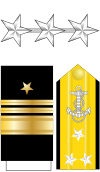
|
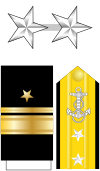
|
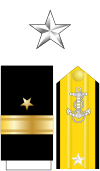
|
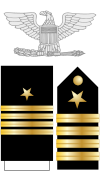
|
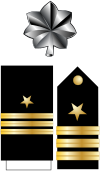
|

|

|
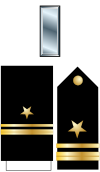
|

|
 (Various insignia) |
|
| Fleet admiral | Admiral | Vice admiral | Rear admiral | Rear admiral (lower half) |
Captain | Commander | Lieutenant commander | Lieutenant | Lieutenant (junior grade) |
Ensign | Midshipman / officer candidate | ||
|

|

|

|

|

|

|

|

|

|

|

|
(Various insignia) | |
| General of the Air Force | General | Lieutenant general | Major general | Brigadier general | Colonel | Lieutenant colonel | Major | Captain | First lieutenant | Second lieutenant | Cadet / Officer trainee | ||
|

|

|

|

|

|

|

|

|

|

|
(Various insignia) | ||
| General | Lieutenant general | Major general | Brigadier general | Colonel | Lieutenant colonel | Major | Captain | First lieutenant | Second lieutenant | Cadet / Officer trainee | |||
|
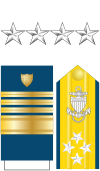
|
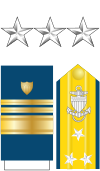
|
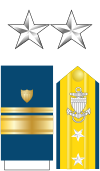
|

|
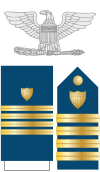
|

|
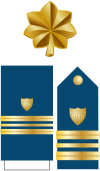
|

|

|

|
Various | ||
| Admiral | Vice admiral | Rear admiral | Rear admiral (lower half) |
Captain | Commander | Lieutenant commander | Lieutenant | Lieutenant (junior grade) |
Ensign | Cadet / officer candidate | |||
| NATO code | OF-10 | OF-9 | OF-8 | OF-7 | OF-6 | OF-5 | OF-4 | OF-3 | OF-2 | OF-1 | OF(D) | Student officer | |
| Uniformed services pay grade | Special grade | O-10 | O-9 | O-8 | O-7 | O-6 | O-5 | O-4 | O-3 | O-2 | O-1 | Officer candidate/Cadet |
Officers represent the top 18% of the armed forces, serving in leadership and command roles.[281] Officers are divided into three categories:[277]
- O-1 to O-3: Company grade officers in the Army, Marine Corps, Air Force, and Space Force or junior officers in the Navy and the Coast Guard.
- O-4 to O-6: Field grade officers in the Army, Marine Corps, Air Force, and Space Force or mid-grade officers in the Navy and Coast Guard.
- O-7 to O-10: General officers in the Army, Marine Corps, Air Force, and Space Force or flag officers in the Navy and Coast Guard.
Officers are typically commissioned as second lieutenants or ensigns with a bachelor’s degree after several years of training and education or directly commissioning from civilian life into a specific specialty, such as a medical professional, lawyer, chaplain, or cyber specialist.[282][283]
Officers are commissioned through the United States service academies, Reserve Officer Training Corps programs, and the Officer Candidate and Officer Training Schools. During a time of war, officers may be promoted to five-star ranks, with general of the Army, fleet admiral, and general of the Air Force the only five-star ranks currently authorized.[284]
Warrant officer corps
| NATO rank | WO-5 | WO-4 | WO-3 | WO-2 | WO-1 |
|---|---|---|---|---|---|
| Uniformed services pay grade | W-5 | W-4 | W-3 | W-2 | W-1 |
|
|||||
| Chief warrant officer 5 | Chief warrant officer 4 | Chief warrant officer 3 | Chief warrant officer 2 | Warrant officer 1 | |
|
|||||
| Chief warrant officer 5 | Chief warrant officer 4 | Chief warrant officer 3 | Chief warrant officer 2 | Warrant Officer 1 | |
|

|

|

|

|

|
| Chief warrant officer 5 | Chief warrant officer 4 | Chief warrant officer 3 | Chief warrant officer 2 | Warrant officer 1
|
|
|

|

|

|
||
| Chief warrant officer 4 | Chief warrant officer 3 | Chief warrant officer 2 | |||
| NATO rank | WO-5 | WO-4 | WO-3 | WO-2 | WO-1 |
| Uniformed services pay grade | W-5 | W-4 | W-3 | W-2 | W-1 |
Warrant officers are specialists, accounting for only 8% of the officer corps.[281] Warrant officers hold warrants from their service secretary and are specialists and experts in certain military technologies or capabilities. The lowest-ranking warrant officers serve under a warrant, but they receive commissions from the president upon promotion to chief warrant officer 2. They derive their authority from the same source as commissioned officers but remain specialists, in contrast to commissioned officers, who are generalists. There are no warrant officers in the Air Force or Space Force.[277]
Warrant officers are typically non-commissioned officers before being selected, with the exception of the Army Aviation where any enlisted grade can apply for a warrant. Army Warrant officers attend the Army Warrant Officer Candidate School.[285]
Enlisted corps
| NATO code | OR-9 | OR-8 | OR-7 | OR-6 | OR-5 | OR-4 | OR-3 | OR-2 | OR-1 | |||||||
|---|---|---|---|---|---|---|---|---|---|---|---|---|---|---|---|---|
| Uniformed services pay grade | Special | E-9 | E-8 | E-7 | E-6 | E-5 | E-4 | E-3 | E-2 | E-1 | ||||||
|

|

|

|

|

|

|

|

|

|

|

|

|
No insignia | |||
| Senior Enlisted Advisor to the Chairman | Sergeant Major of the Army | Command sergeant major | Sergeant major | First sergeant | Master sergeant | Sergeant first class | Staff sergeant | Sergeant | Corporal | Specialist | Private first class | Private | Private | |||
|

|

|

|

|

|

|

|

|

|

|
No insignia | |||||
| Senior Enlisted Advisor to the Chairman | Sergeant Major of the Marine Corps | Sergeant major | Master gunnery sergeant | First sergeant | Master sergeant | Gunnery sergeant | Staff sergeant | Sergeant | Corporal | Lance corporal | Private first class | Private | ||||
|
 Pending Approval |

|

|

|

|

|

|

|

|

|

|

|

|
No insignia | ||
| Senior Enlisted Advisor to the Chairman | Master Chief Petty Officer of the Navy | Fleet/force master chief petty officer | Command master chief petty officer | Master chief petty officer | Command senior chief petty officer | Senior chief petty officer | Chief petty officer | Petty officer first class | Petty officer second class | Petty officer third class | Seaman | Seaman apprentice | Seaman recruit | |||
|

|

|

|

|

|

|

|

|

|

|
No insignia | |||||
| Senior Enlisted Advisor to the Chairman | Chief Master Sergeant of the Air Force | Senior Enlisted Advisor to the Chief of the National Guard Bureau | Command Chief Master Sergeant | First sergeant | Chief master sergeant | First sergeant | Senior master sergeant | First sergeant | Master sergeant | Technical sergeant | Staff sergeant | Senior airman | Airman first class | Airman | Airman basic | |
|
Insignia pending | 
|

|

|

|

|

|

|

|

|

|
|||||
| Senior Enlisted Advisor to the Chairman | Chief Master Sergeant of the Space Force | Chief master sergeant | Senior master sergeant | Master sergeant | Technical sergeant | Sergeant | Specialist 4 | Specialist 3 | Specialist 2 | Specialist 1 | ||||||
|

|

|

|

|

|

|

|

|

|

|

|

|
||||
| Master Chief Petty Officer of the Coast Guard | Master Chief Petty Officer of the Coast Guard Reserve | Command master chief petty officer | Master chief petty officer | Senior chief petty officer | Chief petty officer | Petty officer first class | Petty officer second class | Petty officer third class | Seaman | Seaman apprentice | Seaman recruit | |||||
| NATO code | OR-9 | OR-8 | OR-7 | OR-6 | OR-5 | OR-4 | OR-3 | OR-2 | OR-1 | |||||||
| Uniformed services pay grade | Special | E-9 | E-8 | E-7 | E-6 | E-5 | E-4 | E-3 | E-2 | E-1 |
Enlisted personnel consists of 82% of the armed forces, serving as specialists and tactical leaders.[281] Enlisted personnel are divided into three categories:
- E-1 to E-3/4: Junior enlisted personnel are usually in initial training or at their first assignment. E-1 to E-3 in the Marine Corps, Navy, and Coast Guard, and E-1 to E-4 in the Army, Air Force, and Space Force. In the Army, specialist (E-4) are considered to be junior enlisted, while corporals (E-4) are non-commissioned officers.
- E-4/5 to E-6: Non-commissioned officers in the Army, Marine Corps, Air Force, and Space Force and petty officers in the Navy and Coast Guard. In the Air Force and Space Force, E-5 is the first non-commissioned officer rank. Non-commissioned officers and petty officers are responsible for tactical leadership.
- E-7 to E-9: Senior non-commissioned officers in the Army, Marine Corps, Air Force, and Space Force and chief petty officers in the Navy and Coast Guard. Serve as senior enlisted advisors to officers.
The rank of senior enlisted advisor is the highest rank in each service, serving as the primary advisors to their service secretary and service chief on enlisted matters. Prior to entering their service, enlisted personnel must complete their service’s basic training. In the Army, after completing Basic Combat Training recruits then go to advanced individual training for their military occupational specialty. In the Marine Corps, after completing Recruit Training, marines attend the School of Infantry, going to the Infantry Training Battalion for infantry marines, with non-infantry marines completing Marine Combat Training before advancing to technical training for their military occupational specialty. In the Navy, after completing Recruit Training, sailors advance to their «A» schools to complete training for their rating. In the Air Force and Space Force, recruits complete combined Basic Military Training before going to technical training for their Air Force Specialty Codes. In the Coast Guard, after completing Recruit Training, sailors advance to their «A» schools to complete training for their rating.
Women in the armed forces
All branches of the U.S. military enlisted women during World War II. The Woman’s Army Auxiliary Corps was established by the Army in 1942. Also formed during this time were the Women’s Airforce Service Pilots (WASPs), the Navy’s Women Accepted for Volunteer Emergency Services (WAVES), the Marine Corps Women’s Reserve, and the Coast Guard Women’s Reserve (SPARS).[287] Women saw combat during World War II, first as nurses in the Pearl Harbor attacks on 7 December 1941. In 1944, WACs arrived in the Pacific and in Normandy. During the war, 67 Army nurses and 16 Navy nurses were captured and spent three years as Japanese prisoners of war. There were 350,000 American women who served during World War II, and 16 were killed on duty. In total, they gained over 1,500 medals, citations, and commendations.
After World War II, demobilization led to the vast majority of serving women being returned to civilian life. Law 625, The Women’s Armed Services Act of 1948, was signed by President Harry S. Truman, allowing women to serve in the U.S. Armed Forces in fully integrated units during peace time, with only the WAC remaining a separate female unit. During the Korean War of 1950–1953, many women served in the Mobile Army Surgical Hospitals. During the Vietnam War, 600 women served in the country as part of the Air Force, along with 500 members of the WAC and over 6,000 medical personnel and support staff. The Ordnance Corps began accepting female missile technicians in 1974[288] and female crewmembers and officers were accepted into Field Artillery missile units.[289][290]
In 1974, the first six women naval aviators earned their wings as Navy pilots. The congressionally mandated prohibition on women in combat places limitations on the pilots’ advancement,[291] but at least two retired as captains.[292] The 1991 Gulf War proved to be the pivotal time for the role of women in the U.S. Armed Forces to come to the attention of the world media; there are many reports of women engaging enemy forces during the conflict.[293]
In 1991, women were permitted to fly military aircraft. Since 1994, women can serve on U.S. combat ships.[294] In 2010, the ban on women serving on submarines was lifted.[295]
A female U.S. Air Force fighter pilot at Osan Air Base in South Korea
On 3 December 2015, U.S. defense secretary Ashton Carter announced that all military combat positions would become available to women.[296] This gave women access to the roughly 10% of military jobs which were previously closed off due to their combat nature.[297] These restrictions were due in part to studies which stated that mixed gender units are less capable in combat.[298] The decision gave military services time until January 2016 to provide plans on how they will enforce the policy change.[299] Many women believe this will allow for them to improve their positions in the military, since most high-ranking officers start in combat positions. Since women are now available to work in any position in the military, female entry into the draft has been proposed.[300]
No woman has ever become a Navy SEAL.[301][302] However, in July 2021, the first woman graduated from the Naval Special Warfare (NSW) training program to become a Special Warfare Combatant craft Crewman (SWCC). The SWCC directly supports the SEALs and other commando units, and are experts in covert insertion and extraction special operation tactics.[303][304]
Despite concerns of a gender gap, all personnel, both men and women, at the same rank and time of service are compensated the same rate across all branches.[305] On 1 June 2022, ADM Linda L. Fagan assumed command of the U.S. Coast Guard thus becoming the not only the first woman to serve as Commandant of the Coast Guard but also the first woman in American history to serve as a service chief in the U.S. Military.[306]
A study conducted by the RAND Corporation also suggests that women who make the military their career see an improved rate of promotion, as they climb through the military ranks at a faster rate.[307]
As per the DoD’s report on sexual assault within the U.S. Army for the fiscal year of 2019, 7,825 cases of sexual assault had been reported with the service members either victims or subjects of the assault. There has been a 3% increase in the number of cases as compared to the 2018 report.[308][309]
As of 2021, there are 231,741 women in the military, representing 17.3% of the total active duty force. Since 2017, the percentage of women in active duty service has increased by 1.1%.[310]
Order of precedence
Soldiers, marines, sailors, marines, airmen, guardians, and coast guardsmen from their services ceremonial units stand in formation at Arlington National Cemetery
Under Department of Defense regulation, the various components of the U.S. Armed Forces have a set order of seniority.[311] Examples of the use of this system include the display of service flags, and placement of soldiers, marines, sailors, airmen, guardians, and coast guardsmen in formation.
- Cadets, U.S. Military Academy
- Midshipmen, U.S. Naval Academy
- Cadets, U.S. Air Force Academy
- Cadets, U.S. Coast Guard Academy
- Midshipmen, U.S. Merchant Marine Academy
- United States Army
- United States Marine Corps
- United States Navy
- United States Air Force
- United States Space Force
- United States Coast Guard
- Army National Guard
- United States Army Reserve
- United States Marine Corps Reserve
- United States Navy Reserve
- Air National Guard
- United States Air Force Reserve
- United States Coast Guard Reserve
- Other training and auxiliary organizations of the Army, Marine Corps, Merchant Marine, Civil Air Patrol, and Coast Guard Auxiliary, as in the preceding order.
While the U.S. Navy is older than the Marine Corps,[312] the Marine Corps takes precedence due to previous inconsistencies in the Navy’s birth date. The Marine Corps has recognized its observed birth date on a more consistent basis. The Second Continental Congress is considered to have established the Navy on 13 October 1775 by authorizing the purchase of ships, but did not actually pass the «Rules for the Regulation of the Navy of the United Colonies» until 27 November 1775.[313] The Marine Corps was established by an act of the Second Continental Congress on 10 November 1775. The Navy did not officially recognize 13 October 1775 as its birth date until 1972, when then–chief of naval operations Admiral Elmo Zumwalt authorized it to be observed as such.[312]
The Coast Guard is normally situated after the Space Force, however if it is moved to the Department of the Navy, then its place in the order of precedence changes to being situated after the Navy and before the Air Force.[312]
See also
- American Forces Network
- Awards and decorations of the United States Armed Forces
- Full-spectrum dominance
- List of military equipment of the United States
- List of active United States military aircraft
- List of currently active United States military land vehicles
- List of currently active United States military watercraft
- Military expression
- Provisional Army of the United States
- Servicemembers’ Group Life Insurance
- Sexual orientation and gender identity in the United States military
- Stars and Stripes (newspaper)
- State defense force
- Uniform Code of Military Justice
- United States military casualties of war
- United States military veteran suicide
- United States war crimes
- Women in the United States Army
- Women in the United States Marine Corps
- Women in the United States Navy
- Women in the United States Air Force
- Women in the United States Space Force
- Women in the United States Coast Guard
Notes
- ^ With the establishment of the Continental Army.
- ^ Maximum age for first-time enlistment is 35 for the Army,[1] 28 for the Marine Corps, 34 for the Navy, 39 for the Air Force,[2] 39 for the Space Force,[3] and 27 for the Coast Guard.[4]
Citations
- ^ «United States Army». Goarmy.com. Archived from the original on 29 June 2013. Retrieved 18 June 2013.
- ^ «Contact Us: Frequently Asked Questions». airforce.com. Archived from the original on 20 April 2015. Retrieved 1 April 2015.
- ^ «Join as Enlisted — U.S. Space Force».
- ^ «Plan Your Next Move to Become a Coast Guard Member». Enlisted Opportunities. U.S. Coast Guard. Archived from the original on 28 April 2014. Retrieved 27 April 2014.
- ^ «About Selective Service».
- ^ «FY2023 NDAA: Active Component EndStrength». 23 August 2022. Retrieved 15 February 2023.
- ^ «Appropriations Committee Releases Fiscal Year 2022 Defense Funding Bill». 29 June 2021. Retrieved 3 August 2021.
- ^ «Biden Signs National Defense Authorization Act into Law».
- ^ «Defence Expenditure of NATO Countries (2012–2022)» (PDF). NATO Public Diplomacy Division. 27 June 2022. Retrieved 13 March 2023.
- ^ a b c d e «TIV of arms imports/exports from United States, 2010-2021». Stockholm International Peace Research Institute. 7 February 2022.
- ^ As stated on the official U.S. Navy website Archived 29 June 2011 at the Wayback Machine, «armed forces» is capitalized when preceded by «United States» or «U.S.».
- ^ 10 U.S.C. § 101(a)(4)
- ^ «Trump Signs Law Establishing U.S. Space Force». U.S. DEPARTMENT OF DEFENSE. Retrieved 21 December 2019.
- ^ Note: The other two services being the U.S. Public Health Service Commissioned Corps and the NOAA Commissioned Officer Corps.
- ^ a b «Our Forces». U.S. Department of Defense.
- ^ a b https://www.esd.whs.mil/portals/54/documents/dd/issuances/dodd/510001p.pdf
- ^ O’Sullivan, Michael; Subramanian, Krithika (17 October 2015). The End of Globalization or a more Multipolar World? (Report). Credit Suisse AG. Archived from the original on 15 February 2018. Retrieved 14 July 2017.
- ^ «Trends in World Military Expenditure, 2022» (PDF). Stockholm International Peace Research Institute. April 2023. Retrieved 29 April 2023.
{{cite web}}: CS1 maint: url-status (link) - ^ «Department of Defense | Base Structure Report | FY 2015 Baseline» (PDF). 5 September 2015. Archived from the original (PDF) on 5 September 2015. Retrieved 18 October 2017.
- ^
«’15 Fascinating Facts You Never Learned About America’ – Reader’s digest». rd.com. Archived from the original on 1 April 2017. Retrieved 11 April 2017. - ^ «Coast Guard Organization and Administration, Chapter One». Archived from the original on 3 November 2013. Retrieved 7 October 2013.
- ^ «The US may soon have the world’s first Space Force». Futurism.
- ^ a b «U.S. Army | America’s First National Institution». U.S. Army | America’s First National Institution. Retrieved 18 April 2022.
- ^ a b «Birth of the U.S. Navy». public1.nhhcaws.local. Retrieved 18 April 2022.[permanent dead link]
- ^ «Marine Corps University > Research > Marine Corps History Division > Frequently Requested Topics > Historical Documents, Orders and Speeches > Resolution Establishing the Continental Marines». www.usmcu.edu. Retrieved 18 April 2022.
- ^ «Marine Corps University > Research > Marine Corps History Division > Brief Histories > Brief History of the United States Marine Corps». www.usmcu.edu. Retrieved 18 April 2022.
- ^ «Power to Declare War | US House of Representatives: History, Art & Archives». history.house.gov. Retrieved 18 April 2022.
- ^ «Time Line 1700 — 1800». www.history.uscg.mil. Retrieved 19 April 2022.
- ^ «Time Line 1900’s — 2000’s». www.history.uscg.mil. Retrieved 19 April 2022.
- ^ «Air Force History». Air Force News. 21 November 2017. Retrieved 19 April 2022.
- ^ «Veterans Preference and «Wartime» Service». 15 August 2016. Archived from the original on 21 June 2018. Retrieved 20 November 2018.
- ^ «United States Space Force Facebook Page». Facebook. 20 December 2019.
- ^ «About Space Operations Command». www.spoc.spaceforce.mil. Retrieved 18 April 2022.
- ^ «The 2nd Article of the U.S. Constitution». National Constitution Center – The 2nd Article of the U.S. Constitution. Retrieved 21 April 2022.
- ^ «Operational and Support Components | Homeland Security». www.dhs.gov. Retrieved 27 April 2022.
- ^ «Organization and Management of the Department of Defense» (PDF). Retrieved 18 April 2022.
This article incorporates text from this source, which is in the public domain.
- ^ «DoD Key Leadership Face Charts» (PDF).
- ^ «Time for the Coast Guard to Join the Joint Chiefs». U.S. Naval Institute. 1 August 2020.
- ^ «National Security Council». The White House. Retrieved 20 April 2022.
- ^ «An Active-Duty National Security Advisor: Myths and Concerns». War on the Rocks. 28 February 2017. Retrieved 20 April 2022.
- ^ Geller, Eric. «Trump names Coast Guard official as new homeland security adviser». POLITICO. Retrieved 21 April 2022.
- ^ «Memorandum on Renewing the National Security Council System». The White House. 5 February 2021. Retrieved 20 April 2022.
- ^ «Executive Order on the National Space Council». The White House. 1 December 2021. Retrieved 21 April 2022.
- ^ «Joint Publication 1: Doctrine for the Armed Forces of the United States» (PDF). Joint Chiefs of Staff of the United States Military. 25 March 2013. Archived from the original (PDF) on 28 October 2021. Retrieved 28 September 2021.
- ^ «About». www.stratcom.mil.
- ^ https://www.esd.whs.mil/Portals/54/Documents/DD/issuances/dodd/300006p.pdf[bare URL PDF]
- ^ «About Us». www.dcma.mil.
- ^ «Health Readiness & Combat Support». Military Health System.
- ^ https://www.disa.mil/about/our-work[bare URL]
- ^ «About DIA». www.dia.mil.
- ^ «About the Defense Logistics Agency». www.dla.mil.
- ^ «About Us». www.dtra.mil.
- ^ «About Us | National Geospatial-Intelligence Agency». www.nga.mil.
- ^ «National Security Agency/Central Security Service > About > Central Security Service». www.nsa.gov.
- ^ «National Security Agency Mission and Combat Support». www.nsa.gov.
- ^ «Our Forces». U.S. Department of Defense.
- ^ «The Army’s Vision and Strategy | The United States Army». The Army’s Vision and Strategy | The United States Army.
- ^ «The Official Home Page of the United States Army». www.army.mil.
- ^ a b «ADP1: The Army» (PDF). US Army.
This article incorporates text from this source, which is in the public domain.
- ^ a b c d e f g h i j k l m n o p q r s t u v w x y z aa ab ac ad ae af ag «DoDI 5100.01» (PDF). US Department of Defense.
This article incorporates text from this source, which is in the public domain.
- ^ «It Will be a Long Time Before Soldiers Get the M4 and SAW Replacements». 20 April 2022.
- ^ «101st Airborne Division (Air Assault) :: FORT CAMPBELL».
- ^ «XVIII Airborne Corps :: Fort Bragg».
- ^ «Mountain warfare training rated a solid Mount-ten!».
- ^ «Jungle Operations Training Course challenges mental, physical readiness».
- ^ https://www.benning.army.mil/Infantry/cadet-branching/Content/PDF/Force%20Structure.pdf?24JUN2020[bare URL]
- ^ https://www.benning.army.mil/Infantry/cadet-branching/Content/PDF/Force%20Structure.pdf?24JUN2020[bare URL]
- ^ «Army Rangers».
- ^ «75th Ranger Regiment Home Page».
- ^ «The FN SCAR!».
- ^ «Special Forces».
- ^ «Special Forces».
- ^ «What It Means to be Part of the Army Special Forces». 8 February 2022.
- ^ «Armor Officer».
- ^ https://www.benning.army.mil/armor/Cadet-Branching/content/PDF/Armor%20Branch%20Trifold.pdf?13JUN2022[bare URL]
- ^ «Cadets | Field Artillery Proponent Office (FAPO) | Fort Sill | Oklahoma | Fires Center of Excellence».
- ^ https://tradocfcoeccafcoepfwprod.blob.core.usgovcloudapi.net/fapo/cadets/doc/fa-handbook.pdf[bare URL PDF]
- ^ «The United States Army | Redstone Arsenal Historical Information».
- ^ «‘Confident’ of 2023 Fielding Goal, Army Dubs Hypersonic Weapon ‘Dark Eagle’«. 11 August 2021.
- ^ «First unit fielding Army hypersonic missile in 2023». January 2023.
- ^ «Army resurrects artillery command in Europe». 3 November 2021.
- ^ «OCADA | Fort Sill | Oklahoma | Fires Center of Excellence».
- ^ «OCADA | Fort Sill | Oklahoma | Fires Center of Excellence».
- ^ «OCADA | Fort Sill | Oklahoma | Fires Center of Excellence».
- ^ «32nd Army Air and Missile Defense Command».
- ^ «100th Missile Defense Brigade».
- ^ https://www.smdc.army.mil/Portals/38/Documents/Publications/History/SMDC%20History%20Booklet_508_Final.pdf[bare URL PDF]
- ^ https://www.ausa.org/articles/realign-air-defense-structure[bare URL]
- ^ «Discover». 27 October 2016.
- ^ «Modern Aviation — United States Army Aviation».
- ^ «MQ-1C Gray Eagle Unmanned Aircraft System (UAS) — USAASC».
- ^ «160th SOAR (A) Page».
- ^ «U.S. Army Cyber branch celebrates eighth anniversary».
- ^ «Signal Officer».
- ^ «Space Force Now in Control of All U.S. Military Satellites». 14 September 2022.
- ^ «Organization | The United States Army». Organization | The United States Army.
- ^ «U.S. Army Forces Command | FORSCOM». www.army.mil.
- ^ «U.S. Army Materiel Command | The United States Army». www.army.mil.
- ^ «About – U.S. Army Training Doctrine and Command». www.tradoc.army.mil.
- ^ «Futures | U.S. Army». www.army.mil.
- ^ a b «The Corps». www.marines.mil.
- ^ a b Harkins, Gina (9 January 2020). «‘Fleet Marine Force’ Is Back as Commandant Pushes Return to Naval Roots». Military.com.
- ^ a b c d «Marine Air-Ground Task Force | MAGTF | Marines».
- ^ «All of the Marine M27 rifles are in ― if you’re not a grunt or working with them, you’re not getting one». 21 April 2019.
- ^ «Marines, Navy Corpsmen train in casualty care field exercise at Fort McCoy».
- ^ «The aging Marine LAV is still active across the Corps … And, now, also is a museum piece». 7 January 2019.
- ^ «Ground Combat Roles».
- ^ «How a Marine Corps shift to long ranges may change its strong cannoneer tradition». 9 April 2021.
- ^ «Here’s how Marine air power will shift with the Corps’ 2022 aviation plan». 11 May 2022.
- ^ «Marine Corps Ready to Bring the Sting to Enemy Aircraft, Drones». 3 February 1984.
- ^ «Who We Are».
- ^ «I MEF Information Group».
- ^ «I Marine Expeditionary Force > Units > I MIG > 1ST RADIO BN».
- ^ «Marine Littoral Regiment (MLR)». United States Marine Corps Flagship.
- ^ «Marine Raiders: The Corps’ Only Special Operations Unit».
- ^ «About». www.marforcom.marines.mil.
- ^ «U.S. Marine Corps Forces, Pacific — Ensuring a Free and Open Indo-Pacific». www.marforpac.marines.mil.
- ^ «Marine Corps Systems Command: Equipping Our Marines». www.marcorsyscom.marines.mil.
- ^ «Mission». www.marforres.marines.mil.
- ^ a b «About». www.navy.mil.
- ^ «Naval Warfare 2010–2020: A Comparative Analysis». 6 August 2020.
- ^ «Surface Warfare». www.usna.edu.
- ^ «Aircraft Carriers — CVN». www.navy.mil.
- ^ https://www.nvr.navy.mil/NVRSHIPS/SHIPBATTLEFORCE.HTML[bare URL]
- ^ «Submarines, Carriers, Cruisers & Other Vessels | Navy.com». www.navy.com.
- ^ «Report to Congress on Constellation-class Frigate Program (FFG-62)». 27 December 2022.
- ^ https://www.nvr.navy.mil/NVRSHIPS/FLEETSIZE.HTML[bare URL]
- ^ «Military Units: Navy». U.S. Department of Defense.
- ^ «This video shows the awesomeness of the US Navy’s submarine force». 31 March 2018.
- ^ «Submarines». www.usna.edu.
- ^ «Ballistic Missile Submarines | Commander, Submarine Force, U.S. Pacific Fleet». www.csp.navy.mil.
- ^ «Guided Missile Submarines | Commander, Submarine Force, U.S. Pacific Fleet». www.csp.navy.mil.
- ^ a b c «Aviation Warfare». www.usna.edu.
- ^ «Strategic Communications Wing 1». www.airpac.navy.mil.
- ^ «Home :: Information Warfare :: USNA».
- ^ «Navy Unit Transfers into Space Force, Becomes 10th Space Operations Squadron». 14 June 2022.
- ^ «Deployment offers ‘Sand Sailors’ rare opportunity».
- ^ «Mission».
- ^ «Navy Explosive Ordnance Disposal».
- ^ «Maritime Expeditionary Security Force».
- ^ «Seabees».
- ^ «Naval Special Warfare in a ‘Race for Relevancy’ as Mission Shifts to High-end Conflict». 30 June 2021.
- ^ «Mission». www.usff.navy.mil.
- ^ «About Us». www.af.mil.
- ^ «Air Force Future Operating Concept: A View of the Air Force in 2035» (PDF). airforcemag.com. September 2015. Retrieved 28 September 2021.
- ^ https://www.doctrine.af.mil/Portals/61/documents/Airman_Development/PurpleBook.pdf[bare URL PDF]
- ^ https://www.airandspaceforces.com/PDF/DocumentFile/Documents/2010/CAF_StratPlan2010_091610.pdf[bare URL PDF]
- ^ «F-22 Raptor».
- ^ «If Congress blocks F-22 retirements, expect impact to Air Force drone programs: Hunter». 16 August 2022.
- ^ «F-35A Lightning II».
- ^ «F-35 Completes Final Test for Nuclear-Capable B61 Series Weapons». 5 October 2021.
- ^ «F-15 Eagle».
- ^ «F-15E Strike Eagle».
- ^ «F-15EX Could Replace Strike Eagle Fleet, in Addition to Older C/D Models, USAF Says». 30 July 2020.
- ^ «F-16 Fighting Falcon».
- ^ «The One-Way Nuclear Mission».
- ^ «A-10C Thunderbolt II».
- ^ «B-2 Spirit».
- ^ «B-2 Spirit».
- ^ «B-21 Raider».
- ^ «B-52H Stratofortress».
- ^ «LGM-30G Minuteman III».
- ^ «Sentinel ICBM ‘on track’ for flight test this year: Senior USAF official». 16 February 2023.
- ^ «AC-130J Ghostrider».
- ^ «MC-130J Commando II».
- ^ «CV-22 Osprey».
- ^ «Combat rescue helicopter cuts trigger cost overrun, Air Force says». 12 August 2022.
- ^ «MQ-9 Reaper».
- ^ «Mission».
- ^ «E-3 Sentry (AWACS)».
- ^ «Gen. Minihan Keynote Intro for A/TA 2021».
- ^ «C-5M Super Galaxy».
- ^ «C-17 Globemaster III».
- ^ «C-130 Hercules».
- ^ «VC-25 — Air Force One».
- ^ «KC-46A Pegasus».
- ^ «KC-135 Stratotanker».
- ^ «Major Commands and Reserve Components» (PDF). airforcemag.com. 30 September 2012. Retrieved 28 September 2021.
- ^ «About Us». www.acc.af.mil.
- ^ «Air Education and Training Command > About Us». www.aetc.af.mil.
- ^ «About». www.afgsc.af.mil.
- ^ «About Us». www.afmc.af.mil.
- ^ «About Us». www.afsoc.af.mil.
- ^ «Gen. Minihan Keynote Intro for A/TA 2021». www.amc.af.mil.
- ^ «Our History — U.S. Space Force». www.spaceforce.com.
- ^ «Leadership». www.spaceforce.mil.
- ^ a b c «Space Force releases 1st doctrine, defines «spacepower» as distinct form of military power». United States Space Force.
- ^ «Space Domain Awareness & Combat Power».
- ^ «Space Delta 9 builds orbital warfare tradecraft from the ground up». Schriever Space Force Base (Archived).
- ^ «Space Delta 3 focuses on electromagnetic spectrum». United States Space Command.
- ^ «Entering Year Four, Space Force Focusing on Cyber Capabilities».
- ^ «Space Force coming to grips with cybersecurity threats». 7 July 2022.
- ^ «Space Force embeds Cyber Squadrons into delta missions».
- ^ «Space Force’s Plan for Cyber Warriors». 29 May 2020.
- ^ «Space Force’s Plan for Cyber Warriors». 29 May 2020.
- ^ «U.S. Space Command to Transfer Space Object Tracking to Department of Commerce».
- ^ «Space Delta 2 monitors deep space». Nellis Air Force Base.
- ^ «Premier space surveillance squadron located at Eglin».
- ^ «Space Fence». 7 March 2023.
- ^ «Ground-Based Electro-Optical Deep Space Surveillance».
- ^ «Space Force Rounds Out Delta 2’s Structure».
- ^ «Space Delta 4».
- ^ https://www.raytheonmissilesanddefense.com/news/2022/09/16/all-five-uewrs-complete-second-generation-hardware-software-upgrades[bare URL]
- ^ «Perimeter Acquisition Radar Attack Characterization System».
- ^ https://www.mda.mil/global/documents/pdf/lrdr.pdf[bare URL PDF]
- ^ «SBIRS». 9 August 2022.
- ^ «Defense Support Program Satellites».
- ^ «Space Delta 8». www.schriever.spaceforce.mil.
- ^ «Global Positioning System».
- ^ https://www.gps.gov/applications/timing/[bare URL]
- ^ «NNSA delivers enduring space-based nuclear detonation detection capability».
- ^ «10th Space Operations Squadron».
- ^ «53rd Space Operations Squadron».
- ^ «4th Space Operations Squadron».
- ^ «Advanced Extremely High Frequency System (AEHF)».
- ^ «Assured Access to Space».
- ^ «Assured Access to Space».
- ^ «National security launch in transition as Space Force waits for Vulcan». 19 August 2021.
- ^ «ROCKET CARGO FOR AGILE GLOBAL LOGISTICS – Air Force Research Laboratory».
- ^ «SpaceX signs a deal to rocket military cargo around the world».
- ^ «Space Force begins transition into field organizational structure». United States Space Force.
- ^ «About Space Operations Command». www.spoc.spaceforce.mil.
- ^ https://www.nro.gov/Portals/65/documents/about/leadership/bios/Major_General_Christopher_S_Povak_bio.pdf?ver=Xl0BhACsBe5LE21mmLpDLA%3d%3d[bare URL]
- ^ «Space Force Presents Forces to U.S. Indo-Pacific Command». United States Space Force.
- ^ «14 U.S. Code § 103 – Department in which the Coast Guard operates». LII / Legal Information Institute.
- ^ «United States Coast Guard — Always Ready». www.uscg.mil.
- ^ a b c d e f g «About U.S. Coast Guard Missions». www.uscg.mil.
This article incorporates text from this source, which is in the public domain.
- ^ «United States Coast Guard > Units > Organization». www.uscg.mil.
- ^ «CYBER 101: US Coast Guard Cyber Command (CGCYBER)». U.S. Cyber Command.
- ^ «Ranked: Top 10 Countries by Military Spending». 18 August 2022.
- ^ https://www.armed-services.senate.gov/imo/media/doc/fy23_ndaa_agreement_summary.pdf[bare URL PDF]
- ^ «Congress authorizes 8% defense budget increase». 16 December 2022.
- ^ https://www.afa.org/news/congress-must-stop-dods-misleading-budget-practices-and-end-pass-through-practices[bare URL]
- ^ Cordesman, Anthony H. (7 December 2022). «Strategy and the Congressional National Defense Authorization Act for Fiscal Year 2023».
- ^ «US Army delivers $185.5 billion request for FY24, maintains weapon development portfolio». 13 March 2023.
- ^ «In $255B budget, Navy prioritizes 3 subs and hypersonics, skips amphib buys». 13 March 2023.
- ^ https://comptroller.defense.gov/Portals/45/Documents/defbudget/FY2024/FY2024_Budget_Request.pdf[bare URL PDF]
- ^ «Air Force proposes stagnant workforce, flight time in FY24 budget». 13 March 2023.
- ^ «U.S. Space Force budget hits $30 billion in 2024 proposal». 13 March 2023.
- ^ https://www.dhs.gov/sites/default/files/2023-03/U.S.%20COAST%20GUARD.pdf[bare URL PDF]
- ^ https://comptroller.defense.gov/Portals/45/Documents/defbudget/FY2024/FY2024_Budget_Request.pdf[bare URL PDF]
- ^ https://www.ausa.org/publications/army-readiness-and-modernization-2022[bare URL]
- ^ https://www.ausa.org/publications/army-readiness-and-modernization-2022[bare URL]
- ^ «Bell’s V-280 Valor Just Won the Most Important Army Helicopter Competition in 40 Years». Forbes.
- ^ https://www.ausa.org/publications/army-readiness-and-modernization-2022[bare URL]
- ^ https://www.ausa.org/publications/army-readiness-and-modernization-2022[bare URL]
- ^ https://www.ausa.org/publications/army-readiness-and-modernization-2022[bare URL]
- ^ https://www.ausa.org/publications/army-readiness-and-modernization-2022[bare URL]
- ^ «Next Generation Squad Weapon on target for 2023». 10 October 2022.
- ^ «Analyzing the biggest changes in the Marine Corps Force Design 2030 update». 14 June 2022.
- ^ «Marine Littoral Regiment (MLR)».
- ^ «Top Stories 2022: U.S. Marine Corps Acquisition». 22 December 2022.
- ^ «Top Stories 2022: U.S. Marine Corps Acquisition». 22 December 2022.
- ^ «Navy Moves Out on DDG(X) Requirements».
- ^ «Top Stories 2022: U.S. Navy Acquisition». 26 December 2022.
- ^ «Keel Laying Ceremony Held for First Columbia-Class Ballistic Missile Submarine».
- ^ «Top Stories 2022: U.S. Navy Acquisition». 26 December 2022.
- ^ «Keel Laying Ceremony Held for First Columbia-Class Ballistic Missile Submarine».
- ^ «Top Stories 2022: U.S. Navy Acquisition». 26 December 2022.
- ^ «Top Stories 2022: U.S. Navy Acquisition». 26 December 2022.
- ^ «The U.S. Air Force’s Major Modernization Programs | Aviation Week Network».
- ^ «The B-21 stealth bomber’s first mission: Evading Pentagon red tape». 10 January 2023.
- ^ «The U.S. Air Force’s Major Modernization Programs | Aviation Week Network».
- ^ «The U.S. Air Force’s Major Modernization Programs | Aviation Week Network».
- ^ «Space Force says DARC software on track, following GAO concerns». 16 June 2022.
- ^ «ORACLE – Air Force Research Laboratory».
- ^ «ARACHNE – Air Force Research Laboratory».
- ^ «SPACE POWER BEAMING – Air Force Research Laboratory».
- ^ «NAVIGATION TECHNOLOGY SATELLITE – 3 (NTS-3) – Air Force Research Laboratory».
- ^ «ROCKET CARGO FOR AGILE GLOBAL LOGISTICS – Air Force Research Laboratory».
- ^ «DoD Personnel, Workforce Reports & Publications». dmdc.osd.mil. Defence Manpower Data Centre. Archived from the original on 10 March 2017. Retrieved 7 May 2019.
- ^ «Quick Facts and Figures». Sss.gov. Archived from the original on 12 June 2018. Retrieved 17 October 2017.
- ^ McGill, Kevin (13 August 2020). «Federal appeals court: Male-only draft is constitutional». Associated Press. Retrieved 13 September 2020.
- ^ For example, a lieutenant general in the Air Force is equivalent to a vice admiral in that Navy since they both carry a paygrade of O-9.
- ^ «Department of Defence Instruction 1310.01: Rank and Seniority of Commissioned Officers» (PDF). United States Department of Defense. 6 May 2006. Archived from the original (PDF) on 26 October 2011. Retrieved 9 November 2011.
- ^ https://comptroller.defense.gov/Portals/45/Documents/defbudget/FY2024/FY2024_Budget_Request.pdf[bare URL PDF]
- ^ a b c «U.S. Military Rank Insignia». U.S. Department of Defense.
- ^ a b «U.S. Army Ranks». army.mil. United States Army. Retrieved 27 May 2021.
- ^ a b «Ranks». marines.mil. U.S. Marine Corps. Retrieved 13 June 2021.
- ^ a b c d e f «U.S. Military Rank Insignia». defense.gov. Department of Defense. Retrieved 13 January 2022.
- ^ a b c «Military Careers : Occupational Outlook Handbook: : U.S. Bureau of Labor Statistics». www.bls.gov.
- ^ «Becoming an Officer — Today’s Military». www.todaysmilitary.com.
- ^ Rempfer, Kyle (17 August 2020). «Direct commissions for Army cyber officers finally gaining steam, two-star says». Army Times.
- ^ «These are the 9 general officers who have earned five stars». 28 January 2019.
- ^ «What is a Warrant Officer?». goarmy.com.
- ^ Hadley, Greg (20 September 2021). «Space Force Reveals Insignia for Enlisted Ranks». airforcemag.com. Air Force Magazine. Retrieved 21 September 2021.
- ^ DeSimone, Danielle (1 March 2022). «Over 200 Years of Service: The History of Women in the U.S. Military». USO. Retrieved 7 March 2022.
- ^ «The Women of Redstone Arsenal». United States Army. Archived from the original on 20 June 2008. Retrieved 6 June 2009.
- ^ Busse, Charlane (July 1978). «First women join Pershing training» (PDF). Field Artillery Journal. United States Army Field Artillery School: 40. Archived (PDF) from the original on 18 May 2011. Retrieved 5 June 2009.
- ^ «The Journal interviews: 1LT Elizabeth A. Tourville» (PDF). Field Artillery Journal. United States Army Field Artillery School: 40–43. November 1978. Archived (PDF) from the original on 18 May 2011. Retrieved 5 June 2009.
- ^ «Ocala Star-Banner – Google News Archive Search». News.google.com. Retrieved 18 October 2017.[permanent dead link]
- ^ E. Blake Towler, ed. (May–June 1996). «PEOPLE • PLANES • PLACES» (PDF). Naval Aviation News. pp. 40–44. Archived from the original (PDF) on 25 October 2012. Retrieved 23 December 2012.
- ^ «American Women in Uniform, Desert Storm». Userpages.aug.com. Archived from the original on 11 October 2017. Retrieved 17 October 2017.
- ^ «Twenty-five Years of Women Aboard Combat Vessels». Naval History and Heritage Command. Retrieved 23 December 2022.
- ^ «US navy lifts ban on women submariners». The Guardian. Associated Press. 29 April 2010. ISSN 0261-3077. Archived from the original on 23 December 2016. Retrieved 23 December 2016.
- ^ Baldor, Lolita. «Carter Telling Military to Open all Combat Jobs to Women». Military.com. Associated Press. Archived from the original on 5 December 2015. Retrieved 5 December 2015.
- ^ Lamothe, Dan (3 December 2015). «In historic decision, Pentagon chief opens all jobs in combat units to women». The Washington Post. Archived from the original on 8 December 2015. Retrieved 8 December 2015.
- ^ Tilghman, Andrew (3 December 2015). «All combat jobs open to women in the military». Military Times. Archived from the original on 7 December 2015. Retrieved 8 December 2015.
- ^ Connley, Courtney (7 December 2015). «Breaking Barriers: U.S. Military Opens up Combat Jobs to Women». Black Enterprise. Archived from the original on 8 December 2015. Retrieved 8 December 2015.
- ^ «Now Women Should Register For The Draft». TIME. 7 December 2015. Archived from the original on 3 November 2017. Retrieved 17 October 2017.
- ^ Tritten, Travis J. (10 August 2017). «Candidate to be first female Navy SEAL officer quits after a week». The Washington Examiner.
- ^ Watson, Julie. «Navy: Only woman in SEAL training pipeline drops out». chicagotribune.com. Retrieved 23 October 2020.
- ^ Ives, Mike (16 July 2021). «First Woman Completes Training for Elite U.S. Navy Program». The New York Times. ISSN 0362-4331. Retrieved 24 January 2022.
- ^ «Naval Special Warfare Welcomes CQT Class 115; First Woman Operator». DVIDS. Retrieved 24 January 2022.
- ^ «2018 Pay Chart». 1 January 2018. Archived from the original on 26 April 2018. Retrieved 25 April 2018.
- ^ Sonmez, Felicia (1 June 2022). «Adm. Linda Fagan becomes first woman to lead U.S. Coast Guard». Washington Post. Retrieved 2 June 2022.
- ^ Asch, Beth J.; Miller, Trey; Malchiodi, Alessandro (2012). Significant Gender- and Race/Ethnicity-Based Differences Exist in Rates of Promotion and Retention Among Officers (Report). Archived from the original on 20 April 2018. Retrieved 1 May 2018.
- ^ «Sexual Assault Reports, Harassment Complaints Rise in US Military». Military.com. Retrieved 30 April 2020.
- ^ «Defense Officials Tout Progress in Fight Against Sexual Assault». U.S. Department of Defense. Retrieved 30 April 2020.
- ^ «Department of Defense Releases Annual Demographics Report — Upward Trend in Number of Women». U.S. Department of Defense. Retrieved 23 December 2022.[permanent dead link]
- ^ 10 U.S.C. § 118 (prior section 133b renumbered in 1986); DoD Directive 1005.8 dated 31 October 77 Archived 3 February 2016 at the Wayback Machine and AR 600-25 Archived 6 January 2012 at the Wayback Machine
- ^ a b c Naval History & Heritage Command. «Precedence of the U.S. Navy and the Marine Corps» Archived 10 March 2016 at the Wayback Machine, U.S. Department of the Navy. 11 February 2016
- ^ «Rules for the Regulation of the Navy of the United Colonies of North-America». Naval Historical Center. Department of the Navy. Archived from the original on 23 January 2016. Retrieved 11 February 2016.
External links
- Official U.S. Department of Defense website
Д. Соколов
Структура министерства обороны США (2015)
Структурные изменения в министерстве обороны США, произошедшие в последние годы, свидетельствуют о стремлении его руководства повысить значение Пентагона в системе органов федеральной исполнительной власти и адаптировать его к новым условиям международной обстановки. Как полагают в Вашингтоне, условия формирующегося многополярного мироустройства, текущие и прогнозируемые вызовы и угрозы разноплановым американским интересам диктуют необходимость расширения круга задач, решаемых военным ведомством страны.
В течение последних лет мероприятия по реорганизации Пентагона были направлены в основном на оптимизацию его оргштатной структуры, сокращение административных расходов, повышение эффективности деятельности органов управления и структурных подразделений, повышение оперативности в работе, а также на исключение дублирования функций и уменьшение объемов служебной переписки.
Министерство обороны (Department of Defense — DoD) является органом исполнительной власти США, на который возложена ответственность за решение следующих основных задач:
— поддержка конституционного строя Соединенных Штатов и защита его от внешних и внутренних врагов;
— обеспечение безопасности США, их владений и важных для интересов страны районов путем проведения своевременных и эффективных военных акций;
— защита и продвижение в мире политики и интересов Соединенных Штатов.
Сложившаяся к настоящему времени структура центрального аппарата МО, полномочия и функциональные обязанности его должностных лиц являются итогом многолетней работы по совершенствованию военного ведомства с учетом множества факторов. К основным из них можно отнести следующие: изменение международной обстановки, возникновение новых угроз и вызовов, повышение уровня боеготовности вооруженных сил и военно-экономического потенциала вероятных противников, эволюция способов ведения боевых действий, появление новых видов ВВТ, финансово-экономические возможности страны.
Для успешного решения стоящих перед Пентагоном повседневных и внезапно возникающих задач министру обороны дано право корректировать его структуру, не выходя за рамки установленных законодательством норм. Смена главы МО обычно влечет за собой не только перемены в кадровом составе его аппарата, но и преобразование некоторых центральных органов военного управления. При этом, как правило, новые подразделения министерства, не подтвердившие свою востребованность в течение 1,5 лет, упраздняются, а продемонстрировавшие высокую результативность работы усиливаются и расширяются.
Организационная структура министерства обороны США
Организационная структура аппарата министра обороны США
Повышение эффективности деятельности министерства обороны достигается во многом за счет четкого определения и разграничения полномочий между структурными компонентами и должностными лицами ведомства в сочетании со строгим контролем и персональной ответственностью за состояние дел на порученном участке.
Существующая в настоящее время структура Пентагона включает следующие компоненты:
— аппарат министра обороны;
— три министерства видов ВС (армии, ВВС и ВМС);
— комитет начальников штабов (КНШ) и его объединенный штаб;
— 18 управлений центрального подчинения;
— девять учреждений и служб;’
— девять объединенных командований вооруженных сил США.
Кроме того, в состав министерства обороны входят все организации, функционирующие под непосредственным руководством или контролем вышеназванных органов военного управления.
Наличие в Минобороны ряда структурных компонентов, непосредственно подчиненных главе Пентагона, его полномочия по изменению структуры ведомства позволяют на постоянной основе поддерживать оптимальную, гибкую и эффективно действующую организацию, способную качественно решать стоящие перед ней задачи.
Общая численность органов военного управления Пентагона1 составляет около 200 тыс. человек, в том числе более 135 тыс. гражданских специалистов2.
МО США возглавляет министр обороны. Являясь главным советником президента по вопросам военной политики, он отвечает за разработку и реализацию основных ее направлений, а также за решение других вопросов, имеющих прямое отношение к деятельности военного ведомства. Это лицо осуществляет руководство министерством обороны и вооруженными силами в полном объеме и несет ответственность за их строительство, применение, боевую готовность, материально-техническое обеспечение, проведение НИОКР. Глава Пентагона — постоянный член совета национальной безопасности Соединенных Штатов.
На руководителя американского военного ведомства возложены следующие основные обязанности:
— представлять президенту и конгрессу страны ежегодный доклад о результатах деятельности Минобороны и его расходах за указанный период;
— во взаимодействии с председателем КНШ ежегодно готовить основные руководящие указания для министров видов ВС в отношении подготовки и реализации программ строительства видов вооруженных сил и бюджетных заявок, необходимых для их реализации;
— не реже чем раз в два года разрабатывать и утверждать у президента страны основные руководящие указания для председателя КНШ по подготовке и уточнению оперативных планов задействования ВС США в условиях развязывания военного конфликта, а также в других чрезвычайных обстоятельствах с отражением в них боевого и численного состава привлекаемых сил и средств, объемов материального-технического обеспечения, необходимых для реализации данных планов;
— во взаимодействии с председателем КНШ ежегодно готовить руководящие указания для министров видов вооруженных сил и командующих объединенными командованиями (ОК) ВС США по организации целенаправленной деятельности в интересах своевременного вскрытия и эффективного противодействия потенциальным угрозам национальной безопасности;
— представлять конгрессу страны ежегодный доклад, содержащий комплексную оценку военных программ и боевых возможностей американских вооруженных сил и их союзников в сравнении с аналогичными характеристиками потенциальных противников;
— представлять конгрессу страны ежегодный доклад, содержащий анализ и оценку объемов средств, необходимых для содержания и обеспечения деятельности группировок ВС США за рубежом.
Министр ежедневно получает сводки оперативной информации и доклады командующих объединенными командованиями вооруженных сил страны, разведывательных служб МО, а также сообщения от других федеральных ведомств, в первую очередь от спецслужб. В период нахождения главы Пентагона за границей и во время поездок в пределах американской территории данные сведения предоставляются постоянно сопровождающей его группой специальной закрытой связи. Два раза в неделю министр проводит совещание с членами КНШ ВС США.
Заседания и консультации у руководителя оборонного ведомства обычно проводятся в форме кратких брифингов, на которых после выступления основного докладчика обсуждаются затронутые им вопросы, чаще всего в форме так называемого мозгового штурма, когда все участники высказывают свое мнение.
Министр обороны назначается президентом США из числа гражданских лиц и утверждается сенатом. Лицо, уволившееся с действительной военной службы в офицерском звании, не может быть назначено на должность главы Пентагона в течение семи лет после этого.
Аппарат министра обороны США
Аппарат министра обороны является основным структурным подразделением, ответственным за разработку политики, общее планирование, использование ресурсов, решение финансовых вопросов и оценку военных программ. Он создан и функционирует на основании положений Титула 10 Свода законов США «Вооруженные силы», а также директивы министерства обороны DoD 5100.01 от 21 декабря 2010 года. Аппарат МО включает:
— первого заместителя главы оборонного ведомства;
— пять заместителей министра обороны (по вопросам политики; по приобретению, технологиям и тылу; по личному составу и боеготовности; по разведке; по финансовым вопросам);
— заместителя главного координатора Пентагона по вопросам управления3;
— 16 помощников министра обороны (из которых трое подчиняются министру напрямую, а 13 — его заместителям);
— генерального юрисконсульта, генерального инспектора, главного координатора МО по вопросам внедрения информационных технологий и управления информационными системами (ИС, начальника службы АСУ), которые осуществляют свою деятельность на правах помощников с прямым подчинением главе Пентагона;
— начальников четырех управлений (комплексных оценок; оценки стоимости и анализа программ; войсковых испытаний и оценки; административного), находящихся в непосредственном подчинении министра обороны.
— исполнительный секретариат и группу специальных помощников МО;
Каждый из заместителей и помощников министра обороны имеет собственных заместителей, а также аппарат сотрудников численностью от 20 до 160 человек.
Задачами аппарата министра как самостоятельной организационной единицы, взаимодействующей с другими структурными компонентами Пентагона, являются:
— обеспечение ведущей роли МО в деятельности федеральных органов власти по решению вопросов, связанных с национальной безопасностью США;
— осуществление надзора за эффективностью использования ресурсов и средств, выделяемых на выполнение программ и планов, утвержденных министром обороны;
— разработка и реализация политики, обеспечивающей достижение целей в сфере национальной безопасности США.
Структура аппарата министра обороны не является статичной и в зависимости от складывающейся обстановки и решаемых задач может корректироваться. Изменения, связанные с созданием (упразднением) новых должностей категории «заместитель/помощник министра обороны» и их аппаратов, а также управлений центрального подчинения, санкционируются законодательным решением национального конгресса, утверждаемым президентом страны.
Для этого Пентагон заблаговременно представляет в комитеты по делам вооруженных сил сената и палаты представителей конгресса США детализированную информацию с обоснованием необходимости реорганизационных мероприятий, а также предложения по срокам и формату их проведения. В случае одобрения председатели комитетов выносят данные предложения в форме законодательной инициативы (либо в виде раздела более крупного документа, например проекта военного бюджета, либо в качестве отдельного законопроекта) на голосование обеих палат конгресса. После прохождения соответствующих процедур и подписи проекта закона президентом данные изменения вступают в законную силу.
Менее значимые структурные подразделения аппарата могут создаваться (ликвидироваться) по личному распоряжению главы военного ведомства.
В ходе выполнения реорганизационных мероприятий законодатели и руководство Пентагона исходят из необходимости поддержания эффективно действующей структуры аппарата министра, располагающей необходимыми людскими, материально-техническими и финансовыми ресурсами, способной успешно решать весь комплекс возложенных на нее задач в условиях как мирного, так и военного времени.
Особенностью работы аппарата министра является широкое привлечение, особенно при подготовке актуальных военно-политических решений, авторитетных политиков национального масштаба и ведущих экспертов по конкретным проблемам из независимых научно-исследовательских организаций и центров.
Практически во всех структурных подразделениях аппарата имеются круглосуточные дежурные (обычно младшие офицеры или представители гражданского технического состава).
Максимальная численность аппарата, установленная законодательством, составляет 3 767 человек. В целом, по мнению руководства Пентагона, действующая структура аппарата министра обороны способна эффективно функционировать в любых условиях обстановки.
Важную роль в обеспечении нормального (эффективного) функционирования аппарата министра обороны играет специальный орган — исполнительный секретариат. Подчиняясь непосредственно главе военного ведомства и его первому заместителю, он отвечает за выполнение таких задач, как:
— поддержание рабочих контактов с аппаратом Белого дома, уполномоченными органами других федеральных министерств и ведомств;
— изучение запросов на оказание Пентагоном разнопланового содействия гражданским структурам, подготовка проектов распоряжений и резолюций министра, доведение до исполнителей принятых решений, координация действий и надзор за их выполнением;
— первичная оценка и обработка поступающих на имя министра и его первого заместителя информационно-аналитических материалов и текущей корреспонденции;
— координация деятельности по подготовке «Ежегодного доклада министра обороны США конгрессу», согласование и редактирование проекта данного документа;
— отбор кандидатов для назначения на должности представителей МО в гражданских организациях;
— координация деятельности по подготовке поездок министра и его первого заместителя за рубеж или по территории США;
— назначение ответственных за обеспечение визитов иностранных делегаций;
— рассмотрение и выполнение заявок на перелеты воздушным транспортом представителей аппарата министра обороны.
Организационно исполнительный секретариат состоит из трех отделов:
— отдела военных представителей, который включает в себя четырех старших офицеров (по одному от вида вооруженных сил: сухопутных войск, военно-воздушных сил, военно-морских сил, а также от морской пехоты) и одного-двух административно-технических сотрудников из числа гражданских лиц.
— отдела подготовки и редактирования документов (три гражданских специалиста и до трех технических сотрудников из числа сержантского состава).
— отдела административных и представительских вопросов (три старших офицера и нескольких гражданских помощников).
Структура и состав секретариата могут изменяться по решению министра в зависимости от конкретных условий обстановки.
Группа личных и специальных помощников министра насчитывает 15-20 человек. Ее возглавляет старший военный помощник в звании генерал-лейтенанта. В состав группы входит несколько старших офицеров, относящихся к категории военных помощников, и ряд гражданских лиц — начальники протокольного отдела и личной охраны, а также личные помощники, отвечающие за конкретные участки работы.
При министре обороны осуществляют свою деятельность шесть совещательных и консультативных органов.
Совет министерства обороны по приобретению (Defense Acquisition Board) — совещательный орган в структуре Пентагона, главной задачей которого является подготовка рекомендаций главе американского военного ведомства по вопросам реализации программ приобретения вооружения и военной техники. Возглавляет совет заместитель министра обороны по приобретению, технологиям и тылу. В него также входят: министры армии, ВВС и ВМС; заместитель председателя КНШ; заместитель министра обороны по финансовым вопросам — главный финансовый инспектор; заместитель МО по вопросам политики; заместитель министра обороны по личному составу и боеготовности; главный координатор МО по вопросам внедрения информационных технологий и управления информационными системами (начальник службы АСУ); начальник управления оценки стоимости и анализа программ; начальник управления комплексных оценок. Кроме того, в случае необходимости к работе совета могут привлекаться специалисты других структурных подразделений Пентагона.
Объединенный совет по тылу (Joint Logistics Board) — совещательный орган при министре обороны и председателе КНШ, главная задача которого заключается в подготовке рекомендаций по вопросам тылового и материально-технического обеспечения вооруженных сил. Сопредседателями совета являются помощник министра обороны по тылу и МТО и начальник управления тыла объединенного штаба КНШ. Членами совета также являются заместители начальников штабов армии, ВВС, ВМС и морской пехоты по тылу, командующий объединенным командованием стратегических перебросок ВС США, командующие командованиями материально-технического обеспечения армии и ВМС, командующий командованием снабжения ВМС.
Совет министерства обороны по науке (Defense Science Board) — независимый консультативный орган Пентагона по вопросам научной деятельности, реализации программ НИОКР и организации производства вооружения и военной техники. Члены совета назначаются министром обороны ежегодно в количестве не более 45 экспертов на период от одного до четырех лет из числа гражданских специалистов, не занимающих на постоянной основе должности в федеральных органах власти. При этом министр обороны назначает председателя совета, а заместитель главы военного ведомства по приобретению, технологиями тылу — его заместителя. Кроме того, замминистра обороны по этим вопросам может в случае необходимости дополнительно назначать в состав совета специальных экспертов и наблюдателей без права голоса, которые не имеют статуса полноправных и постоянных его членов.
Совет министерства обороны по политическим вопросам (Defense Policy Board Advisory Committee) — готовит для министра обороны, его первого заместителя и заместителя по вопросам политики независимые рекомендации в военно-политической сфере. В своей работе совет уделяет особое внимание проблемам долгосрочного планирования и выработке решений стратегического уровня. В его состав, как правило, входят бывшие высшие должностные лица Пентагона и государственного департамента, руководящие сотрудники ведущих американских аналитических центров и университетов.
Совет по ядерному оружию (Nuclear Weapons Council) является объединенным совещательным, консультативным и координирующим органом министерств обороны и энергетики по вопросам развития и поддержания боеготовности ядерного оружейного комплекса США. Его возглавляет заместитель министра обороны по приобретению, технологиям и тылу. В его состав входят: заместитель председателя КНШ, глава национальной администрации по ядерной безопасности (входит в структуру министерства энергетики), заместитель министра обороны по вопросам политики, командующий объединенным стратегическим командованием ВС США. Исполнительный секретарь совета — помощник министра обороны по ядерным, химическим и биологическим программам.
Кроме того, в работе совета по ядерному оружию могут принимать участие члены совета национальной безопасности США, начальники штабов ВВС и ВМС, начальник управления оценки стоимости и анализа программ, заместитель министра обороны по разведке, заместитель министра обороны по финансовым вопросам — главный финансовый инспектор, глава управления МО по снижению угрозы.
Совет по вопросам использования резервных сил (Reserve Forces Policy Board) — независимый консультативно-совещательный орган Пентагона по вопросам расширения возможностей и повышения эффективности задействования резервных компонентов вооруженных сил. В состав совета численностью 20 человек входят: председатель (гражданское лицо), представитель руководства (действующий или бывший) каждого из семи резервных компонентов ВС США, двое военнослужащих регулярных вооруженных сил в ранге генерал-майора (двухзвездного генерала), помощник министра обороны по резервам, а также десять экспертов в области обеспечения национальной безопасности и использования резервных компонентов.
При совете созданы четыре постоянных подкомитета: поддержания готовности оперативных резервов; кадровой политики; повышения роли резервных компонентов в обеспечении внутренней безопасности; поддержки военнослужащих и гражданских служащих, членов их семей и работодателей. Заседания совета проводятся 4 раза в год.
К министерствам видов вооруженных сил США относятся министерства армии, ВВС и ВМС (морская пехота входит в состав министерства ВМС). Каждое из них имеет свою структуру, возглавляется соответствующим министром и функционирует под общим руководством и контролем главы Пентагона.
Министерства видов ВС несут ответственность за организацию повседневной деятельности подчиненных им структур; комплектование личным составом, его обучение и подготовку; материально-техническое и тыловое обеспечение; проведение НИОКР и оснащение вооружением и военной техникой войск (сил), выделяемых в состав оперативных формирований; ремонт и техническое обслуживание ВВТ; организацию и осуществление мобилизационных мероприятий; строительство военных объектов и инфраструктуры.
В состав каждого министерства входят: аппарат министра, состоящий из его заместителей и помощников; штаб вида вооруженных сил (для ВМС — штаб военно-морского флота и МП); различные управления, а также основные и вспомогательные (для ВМС — межфлотские и береговые) командования.
Министры видов ВС осуществляют административное управление войсками (силами), переданными в состав объединенных командований, через командующих видами ВС в зонах (или в составе функциональных ОК). Административное руководство войсками (силами), находящимися в подчинении командующих ОК, они осуществляют через начальников штабов своих видов ВС.
Начальники штабов видов ВС назначаются президентом с согласия сената сроком на четыре года. В условиях военного времени и чрезвычайных ситуаций, официально объявленных конгрессом США, возможно продление их полномочий на срок до четырех лет.
Общая численность сотрудников министерств видов вооруженных сил составляет более 10 тыс. человек, включая около 4,5 тыс. гражданских специалистов.
Организационная структура комитета начальников штабов ВС США
Комитет начальников штабов — высший консультативный, планирующий и исполнительный орган, с помощью которого президент и министр обороны осуществляют руководство вооруженными силами и координируют планы их развития.
Основными функциями КНШ являются: разработка планов строительства, подготовки, оснащения и тылового обеспечения ВС; планирование мобилизационного, стратегического и оперативного развертывания ВС и мобразвертывания экономики страны; рассмотрение и представление на утверждение министру обороны и верховному главнокомандующему (президенту) оперативных планов задействования объединенных командований ВС США; разработка планов операций и войны в целом.
В состав комитета начальников штабов, возглавляемого председателем КНШ, входят заместитель председателя КНШ, начальники штабов армии, ВМС и ВВС, комендант морской пехоты и директор бюро национальной гвардии.
Председатель КНШ (штатная категория генерал или адмирал) назначается президентом и утверждается сенатом из числа высших офицеров сроком на два года (в мирное время срок пребывания на должности может быть продлен до четырех лет, а в военное продолжительность полномочий не ограничена). Он является главным военным советником президента, СНБ и министра обороны. Председатель КНШ не выполняет командных функций, однако президент или министр обороны могут делегировать ему часть своих полномочий.
Деятельность КНШ обеспечивает объединенный штаб (ОШ) — основной рабочий орган комитета. ОШ, подчиняющийся председателю КНШ, отвечает за формирование концептуальных основ применения американских ВС, не имея при этом полномочий по оперативному управлению вооруженными силами. Его главная задача состоит в разработке и подготовке материалов для принятия решений на заседаниях КНШ.
ОШ КНШ должен оказывать содействие председателю комитета начальников штабов по следующим вопросам:
— стратегическое руководство войсками (силами);
— проведение операций в составе объединенных командований;
— координация действий сил сухопутного, морского и воздушного компонентов вооруженных сил.
Во главе ОШ стоит начальник в звании генерал-лейтенанта (вице-адмирала), назначаемый председателем КНШ после консультаций с другими членами комитета и с согласия министра обороны. Он организует работу штаба и по указанию председателя комитета присутствует на заседаниях последнего. Начальник объединенного штаба уполномочен рассматривать широкий круг вопросов и принимать решения по ним при условии, что они не затрагивают сфер компетенции членов КНШ, заведомо не противоречат взглядам и общей линии комитета и не вызывают разногласий среди представителей различных видов ВС. В случае если входящий в компетенцию комитета начальников штабов вопрос не является настолько важным, чтобы требовалось его обсуждение на этом уровне, то решение и документальное оформление данного вопроса могут быть возложены на начальника ОШ.
Организационно ОШ состоит из управления административных служб и восьми основных (оперативных) управлений: личного состава; разведывательного обеспечения; оперативного; тыла; стратегического планирования и политики; систем управления, связи и компьютерного обеспечения; оперативного планирования и организации взаимодействия видов ВС; структуры сил, ресурсов и оценок.
Объединенный штаб комплектуется офицерами и генералами (адмиралами) всех видов вооруженных сил. Представители видов ВС поочередно занимают должности начальника объединенного штаба и его заместителя, а также начальников управлений ОШ и их заместителей.
Общая численность личного состава КНШ и его объединенного штаба около 4 тыс. человек.
Учитывая динамично меняющуюся ситуацию в мире, возникновение новых вызовов и угроз национальной безопасности Соединенных Штатов, а также быстрое развитие науки и техники, Белый дом и в перспективе планирует уделять повышенное внимание совершенствованию деятельности Пентагона. При этом основными направлениями дальнейшего реформирования МО являются адаптация его организационно-штатной структуры к современным условиям обстановки в интересах решения комплексных задач в области обороны и безопасности, укрепление позиций США на международном рынке ВВТ, а также повышение роли и самостоятельности военного ведомства в решении финансово-экономических вопросов.
В соответствии с принятым в декабре 2013 года главой Пентагона решением 1 января 2015 года был сокращен ряд должностей старшего и среднего руководящего состава аппарата министра обороны США, были упразднены мелкие структурные подразделения, объединены подразделения со схожими и дублирующими функциями, а также переподчинены отдельные управления, службы и отделы аппарата между его заместителями и помощниками. В целом численность центральных органов военного управления уменьшилась на 8 %
Так, в аппарате заместителя главы оборонного ведомства по вопросам политики упразднили одну должностную категорию — «заместитель заместителя министра обороны» и четыре — «заместитель помощника министра обороны».
В дальнейшем планом реорганизационных мероприятий предполагается вывести управление комплексных оценок Пентагона из подчинения первого заместителя министра обороны и передать под руководство замминистра обороны США по вопросам политики.
Кроме того, предусматривается передача всей полноты ответственности за реализацию программ приобретения, развития и применения информационно-телекоммуникационных систем в интересах обеспечения деятельности Пентагона главному координатору МО по вопросам информационных систем и технологий.
В целом, по оценкам руководства министерства обороны США, реализация намеченных реорганизационных мероприятий позволит в 2015-2019 годах обеспечить экономию финансовых средств ведомства в размере 1 млрд долларов.
1 Включение той или иной структуры Пентагона в категорию «центральные органы военного управления» определяется соответствующими положениями национальной нормативно-правовой базы — Титул 10 Свода законов США («Вооруженные силы») глава 4 «Аппарат министра обороны», глава 5 «Комитет начальников штабов», глава 8 «Управления и другие органы центрального подчинения»; директива министра обороны DODD №5100.01 от 21.12.2010 г. «Функции и полномочия военного ведомства и его основных компонентов».
2 К категории «гражданские специалисты» в МО США относят всех гражданских лиц, принятых на постоянную работу в интересах Пентагона, в том числе обслуживающий персонал — работники коммунальных служб, продавцы и т. д.
3 Обязанности плавного координатора Пентагона по вопросам управления возложены на первого заместителя министра обороны (Свод законов США, Титул 10 «Вооруженные силы», глава 4, раздел 132).
Источник: Зарубежное военное обозрение. 2015, №2, С.11-19, Полковник Д. Соколов
Общая оценка материала: 4.9
Оценка незарегистрированных пользователей:
Политика ,
02 апр 2022, 08:39
0
Пентагон сменил главу Центрального командования войск США
Генерал Сухопутных войск США Майкл Курилла стал новым главой Центрального командования Вооруженных сил (Centcom). На этом посту он сменил генерала Кеннета Маккензи, сообщили в пресс-службе Пентагона.
«Кеннет Маккензи передал командование Центральным командованием США генералу армии Майклу Курилле», — говорится в сообщении.
Глава Минобороны США Ллойд Остин отметил, что руководство центральным командованием — «тяжелая миссия», к которой Курилла готов.
Маккензи возглавлял Центральное командование с марта 2019 года. Под его руководством США завершили вывод войск из Афганистана, ликвидировали лидера «Исламского государства» (признано террористическим и запрещено в России), а также командующего силами специального назначения «Аль-Кудс» Корпуса стражей исламской революции генерал Касема Сулеймани.
Курилла ранее командовал 18-м воздушно-десантным корпусом американской армии, который отвечает за переброску в любую точку мира. Его направили в Германию, чтобы курировать вопросы, связанные с Украиной.
Centcom занимается планированием операций на Ближнем Востоке, Центральной Азии и на территории восточной части Африки.
Список военачальников США — перечисление четырёхзвездочного офицерского состава Соединенных Штатов. В настоящего время служат 40 офицеров: 11 в Армии, 4 в Корпусе морской пехоты, 11 во Флоте, 13 в ВВС, 1 в береговой охране. В государственной службе здравоохранения эксплуатационного корпуса нет четырёхзвездочного офицера.
Из семи федеральных силовых структур Национальное управление океанических и атмосферных эксплуатацию корпуса является единственной службой, которая не имеет в структуре четырёхзвездочного офицера.
Содержание
- 1 Список высших офицеров
- 1.1 Объединенный комитет начальников штабов
- 1.2 Главы различных командных структур
- 1.3 Другие
- 1.4 Армия США
- 1.5 Морская пехота США
- 1.6 ВМФ
- 1.7 ВВС
- 1.8 Береговая охрана
- 1.9 Службы здравоохранения США эксплуатационный корпус
Список высших офицеров
Объединенный комитет начальников штабов
| Структура | Фото | На данный момент | Служба |
|---|---|---|---|
| Председатель Объединенного комитета начальников штабов (CJCS) |  |
Михаил Дж. Муллен | ВМФ США |
| Вице-председатель Объединенного комитета начальников штабов (VJCS) |  |
Генерал Джеймс Е. Картвингер | Морская пехота США |
Главы различных командных структур
| Структура | Фото | На данный момент | Служба |
|---|---|---|---|
| Командующий, Африканское командование США (USAFRICOM) |  |
Генерал Уильям Уорд | Армия США |
| Командующий, Центрального командования США (USCENTCOM) |  |
Генерал Джеймс Н. Маттис | Морская пехота США |
| Командующий, Европейским командованием США (USEUCOM) и Верховный главнокомандующий объединенными вооруженными силами НАТО в Европе (SACEUR) |  |
ADM Джеймс Дж. Ставридис | Военно-морские силы США |
| Командующий США Объединенного командования сил (USJFCOM) |  |
Генерал Рейдмон Т. Одиерно | Армия США |
| Командующий, Северное командование США (USNORTHCOM) и Командующий Североамериканского аэрокосмического оборонного команду(NORAD) |  |
ADM Джеймс А. Виннефилд-младший | Военно-морские силы США |
| Командующий, Тихоокеанского командования США (USPACOM) |  |
ADM Роберт Ф. Виллард | Военно-морские силы США |
| Командующий Южным командованием США (USSOUTHCOM) |  |
Генерал Дуглас М. Фрейзер | Военно-воздушные силы США |
| Командующий США специальная команда операций(USSOCOM) |  |
ADM Эрик Олсон Т. | Военно-морские силы США |
| Командующий стратегическим командованием США (USSTRATCOM) |  |
Генерал Кевин П. Чилтон | Военно-воздушные силы США |
| Командующий транспортного командования США (USTRANSCOM) |  |
Gen Дункан Дж. Макнабб | Военно-воздушные силы США |
Другие
| Структура | Фото | На данный момент | Служба |
|---|---|---|---|
| Начальник Бюро Национальной гвардии (CNGB) |  |
Генерал Крэйг Р. Мак-Кинли | Военно-воздушные силы США |
| Командующий Международными силами содействия безопасности (ISAF) и Командующий ВС США в Афганистане (USFOR-A) |  |
Генерал Дэвид Х. Петреус | Армия США |
| Командующий силами Организации Объединенных Наций (UNC) Командующий США Командование объединенных сил (CFC) и Командующий ВС США в Корее (USFK) |
 |
Генерал Уолтер Л. Шарп | Армия США |
| Командующий генерал, ВС США — Ирак (USF-I) |  |
Генерал Ллойд Дж. Остин III | Армия США |
| Директор, Агентство национальной безопасности (NSA), Начальник Центральной службы безопасности (CSS) и Командующий США Cyber Командная (USCYBERCOM) |
 |
Генерал Кейт Б. Александ | Армия США |
Армия США
| Структура | Фото | На данный момент |
|---|---|---|
| Начальник штаба армии США (CSA) |  |
Генерал Джордж Кейси-младшего |
| Заместитель начальника штаба армии США (VCSA) |  |
Генерал Питер В. Кьярелли |
| Командующий генерал, в Европе (USAREUR) |  |
Генерал Джордж Картер Хэм Ф. |
| Командующий генерал, ВС США (FORSCOM) |  |
Генерал Джеймс Д. Турман |
| Командующий генерал, армия США материальное снабжение (AMC) |  |
Генерал Энн Э. Данвуди |
| Командующий генерал, США Обучение армии и Командование по разработке доктрины (TRADOC) |  |
Генерал Мартин Е. Демпси |
Морская пехота США
| Структура | Фото | На данный момент |
|---|---|---|
| Комендант морской пехоты (CMC) |  |
Генерал Джеймс Т. Конвей |
| Помощник коменданта морской пехоты (ACMC) |  |
Генерал Джеймс Ф. Амос |
ВМФ
| Структура | Фото | На данный момент |
|---|---|---|
| Начальник военно-морских операций (CNO) |  |
Адмирал Гэри Роугхед |
| Заместитель начальника военно-морских операций (VCNO) |  |
Адмирал Джонатан У. Греенет |
| Командующий, ВС США командной флота, (USFLTFORCOM) |  |
Адмирал Джон С. Харви-младший |
| Командующий ВМС США Европа сил (USNAVEUR), Командующий ВМС США Африки сил (USNAVAF) and Командующий союзными Совместное Неаполь командной группы (JFC Naples) |
 |
Адмирал Марк П. Фицджеральд |
| Командующий, Тихоокеанского флота США (USPACFLT) |  |
Адмирал Патрик М. Уолш |
| Директор, Морской ядерного движения и Заместитель Администратора, Национальное управление ядерной безопасности в военно-морских реакторов |  |
Адмирал Киркланд Х. Доналд |
ВВС
| Структура | Фото | На данный момент |
|---|---|---|
| Начальник штаба ВВС США (CSAF) |  |
Генерал Нортон Шварц А. |
| Заместитель начальника штаба ВВС США (VCSAF) |  |
Генерал Каррол H. Чандлер |
| Командующий боевого авиационного командования (ACC) |  |
Генерал Уильям М. Фрейзер III |
| Командующий Обучения в воздухе и учебного командования (AETC) |  |
Генерал Стивен Р. Лоренц |
| Командующий ВВС материально-командной (AFMC) |  |
Генерал Дональд Дж. Хоффман |
| Космическое командование (AFSPC) |  |
Генерал С. Роберт Келер |
| Командующий, мобильное авиационное командование (AMC) |  |
Генерал Раймонд Е. Джонс младший |
| Командующий ВВС Тихоокеанского района (PACAF) |  |
Генерал Гарри Л. Норт |
| Командующий ВВС США в Европе (USAFE) Командующий авиационного командования, Рамштайн (AIR-COM Ramstein) and Директор Объединенной Воздушного Центра (JAPCC) |
 |
Генерал Роджер А. Брейди |
Береговая охрана
| Структура | Фото | На данный момент |
|---|---|---|
| Комендант береговой охраны США |  |
Адмирал Роберт Дж. Папп |
Службы здравоохранения США эксплуатационный корпус
| Структура | Фото | На данный момент |
|---|---|---|
| Помощник секретаря по вопросам здравоохранения |  |
Говард Кох (Гражданский) |
| |
|||||||||||||
|---|---|---|---|---|---|---|---|---|---|---|---|---|---|
| Руководство |
Верховный главнокомандующий · Министр обороны · Заместитель министра обороны · Объединённый комитет начальников штабов · Комитет Вооруженных сил · |
||||||||||||
| Организационная структура |
|
||||||||||||
| Подразделения |
Пентагон · Военные базы · Бюджет · Подразделения: А, МП, ВМС, ВВС, БО |
||||||||||||
| Операции и история |
Присутствие в других странах · Конфликты · Войны · История · Корабли ВМС США, потерянные во Второй мировой войне: (1—229) · (230—527) · (528—714) · XXI век |
||||||||||||
| Персонал |
|
||||||||||||
| Оружие |
|


